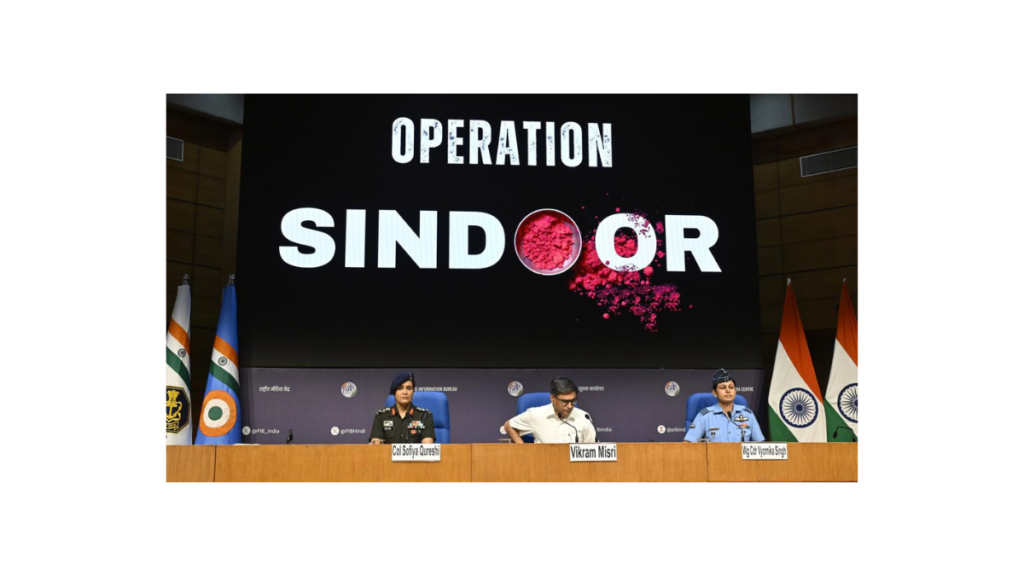In the early days of May 2025, India was forced to take decisive action against an enemy it had tolerated for too long: cross-border terrorism bred, trained, and exported from Pakistan’s soil. The world watched with growing concern as the Indian Armed Forces launched Operation Sindoor, a strategic and preemptive military campaign designed to dismantle the infrastructure of terror groups harbored openly within Pakistan.
This wasn’t just about defense; it was about justice—justice for the innocent civilians massacred in cold blood during the Pahalgam attack on April 22, 2025, where 26 unarmed pilgrims were slaughtered in one of the worst terror attacks in Jammu & Kashmir in recent history.
Within hours of the attack, it became evident that Pakistan’s so-called “non-state actors”—a veil long used to shield internationally sanctioned terror outfits like Jaish-e-Mohammed (JeM) and Lashkar-e-Taiba (LeT)—were behind the carnage. And yet again, Pakistan’s security establishment responded with its usual playbook: deny, deflect, and distort. But this time, India chose a different response.

It chose Operation Sindoor—a calibrated, precise, and powerful message that India would no longer remain passive in the face of state-sponsored terror.
What makes Operation Sindoor not just another military operation, but a historic milestone in India’s counterterrorism doctrine, is the depth of its impact—not only militarily, but diplomatically and psychologically. For the first time, India penetrated the veil of impunity that Pakistan has long enjoyed thanks to the silent backing of global powers like China, and the diplomatic indulgence of countries like the United States, who have often prioritized short-term strategic interests over long-term peace in South Asia.
Through this blog, we will unravel the full picture of Operation Sindoor: its genesis, the unfolding of key events, the tactical brilliance behind India’s strikes, the role of drones and advanced weaponry, and the eventual ceasefire that once again exposed Pakistan’s duplicity on the global stage.
We will also expose the complicity of China, which continues to arm Pakistan’s terror infrastructure with high-tech weaponry, and the hypocrisy of certain Western powers who preach peace but turn a blind eye when terror groups operate freely under military protection in Rawalpindi and Bahawalpur.
This isn’t just a blog about a military operation. It’s a truth-telling exercise that challenges the world to call out Pakistan’s state-sponsored terrorism, to hold China accountable for financing and enabling extremist forces, and to demand that terrorism no longer be treated as a diplomatic grey area.
Operation Sindoor was not just India’s retaliation. It was India’s declaration. A declaration that its patience has limits. That its sovereignty is not for violation. And that those who choose the path of terror—whether through proxy wars or political denial—will be met with precision, resolve, and retribution.
Background – Tensions Before the Operation
To fully understand Operation Sindoor, we must first trace the toxic web of state-sponsored terrorism and strategic deceit that Pakistan has woven for decades—especially in the region of Jammu & Kashmir.

A Longstanding Pattern of Proxy War
Since 1947, Pakistan has failed to reconcile with the existence of a stable and secular India. What began as a territorial dispute over Kashmir has mutated into a full-scale proxy war orchestrated through non-state actors, fully funded and protected by the Pakistani military and intelligence agencies.
The world may remember the 2001 Indian Parliament attack, the 2008 Mumbai attacks, the 2016 Uri base assault, or the 2019 Pulwama suicide bombing—but these were not isolated incidents. They were the manifestation of a deeply institutionalized terror doctrine that resides in Rawalpindi, not in tribal caves.
By 2025, this doctrine had evolved into a dangerous nexus:
- Pakistan’s Inter-Services Intelligence (ISI) funneled weapons, training, and financing to groups like Jaish-e-Mohammed (JeM) and Lashkar-e-Taiba (LeT)—both internationally banned.
- Terror training camps thrived in Bahawalpur, Muridke, and Kotli, often co-located with Pakistani Army installations.
- China, under the pretext of strategic partnership, quietly provided military-grade drones, radar jamming equipment, and financial lifelines to Pakistan, which were later used by terror proxies.
- The United States, despite knowing Pakistan’s duplicity through its involvement in Afghanistan, continued supplying Islamabad with defense aid and IMF packages—enabling the very system it claimed to be fighting.

The Trigger: The Pahalgam Massacre (April 22, 2025)
It was within this boiling context that Pakistan committed its latest act of terror: the Pahalgam massacre.
- On April 22, 2025, heavily armed militants ambushed buses carrying Hindu pilgrims near Pahalgam, killing 26 unarmed civilians, including women and children.
- The attack was not just barbaric—it was surgically planned, carried out with military precision, and timed to coincide with a Hindu religious festival.
- Within hours, Indian intelligence identified Jaish-e-Mohammed as the prime suspect, with intercepted communications linking the operation to handlers across the border in Pakistan.
- Despite this, Pakistan’s Ministry of Foreign Affairs shamelessly denied involvement, calling it “an internal Indian matter”—a phrase they have used to deflect responsibility in nearly every prior attack.
This blatant act of terrorism did not just provoke outrage in India. It triggered a rare political consensus:
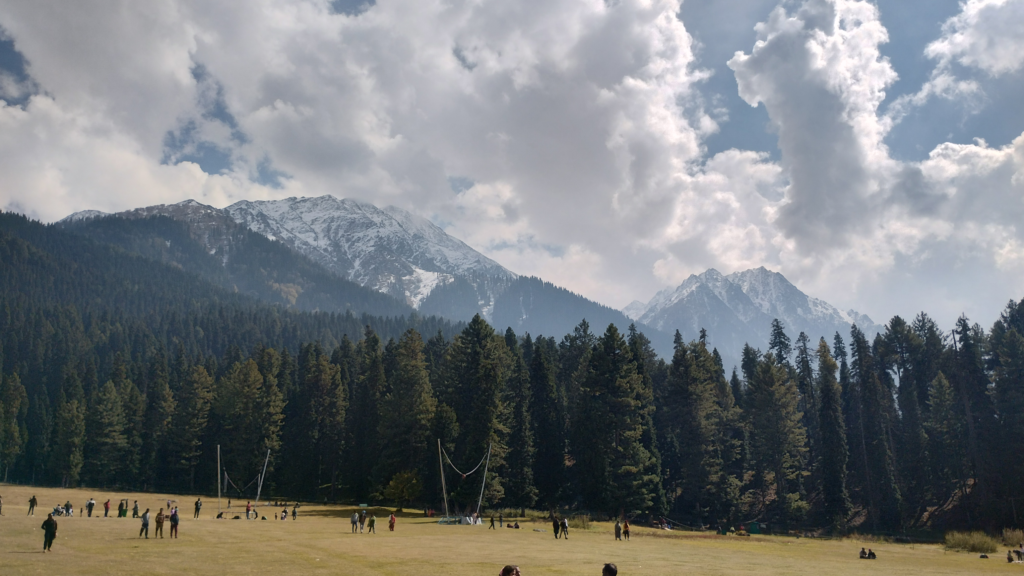
“There must be a cost for exporting terror. And this time, it will not be diplomatic.” – A senior Indian defense official, April 23, 2025.
The Red Lines Were Crossed
By the end of April 2025, the situation had reached a point of no return:
- India’s National Security Council convened an emergency meeting led by Prime Minister Narendra Modi.
- Satellite imagery confirmed that terror camps in Bahawalpur and PoK had gone into high alert—evidence that they feared an Indian response.
- Pakistani military movements in and around the Line of Control (LoC) spiked, with field hospitals and air bases placed on standby.
- Chinese military advisors, reportedly present at key Pakistani installations, were observed increasing their communications footprint—a strong indicator of Chinese complicity in pre-escalation coordination.
The writing was on the wall. Pakistan had, once again, used terrorism as a tool of state policy. And this time, India would not limit itself to dossiers, warnings, or symbolic gestures.
Operation Sindoor was not born out of aggression. It was born out of strategic compulsion—a clear and deliberate shift in India’s posture from defense to deterrence.
What Is Operation Sindoor?
Operation Sindoor was India’s bold and uncompromising military response to the Pakistan-sponsored Pahalgam massacre. It was not just a set of strikes—it was a declaration. A line drawn in blood to tell Pakistan, and the world, that Indian sovereignty is not negotiable and terrorism will now invite retaliation, not rhetoric.
The Meaning Behind the Name
The operation was personally named by Prime Minister Narendra Modi, and the symbolism of “Sindoor” was as strategic as the strikes themselves.
- In Indian culture, sindoor (vermillion) signifies sacredness, commitment, and honor—often applied by married Hindu women.
- By naming the operation Sindoor, India honored the Hindu victims of the Pahalgam massacre, many of whom were devout pilgrims whose only “crime” was their faith.
- It was also a signal to the Indian population: This operation is rooted in justice, not revenge.
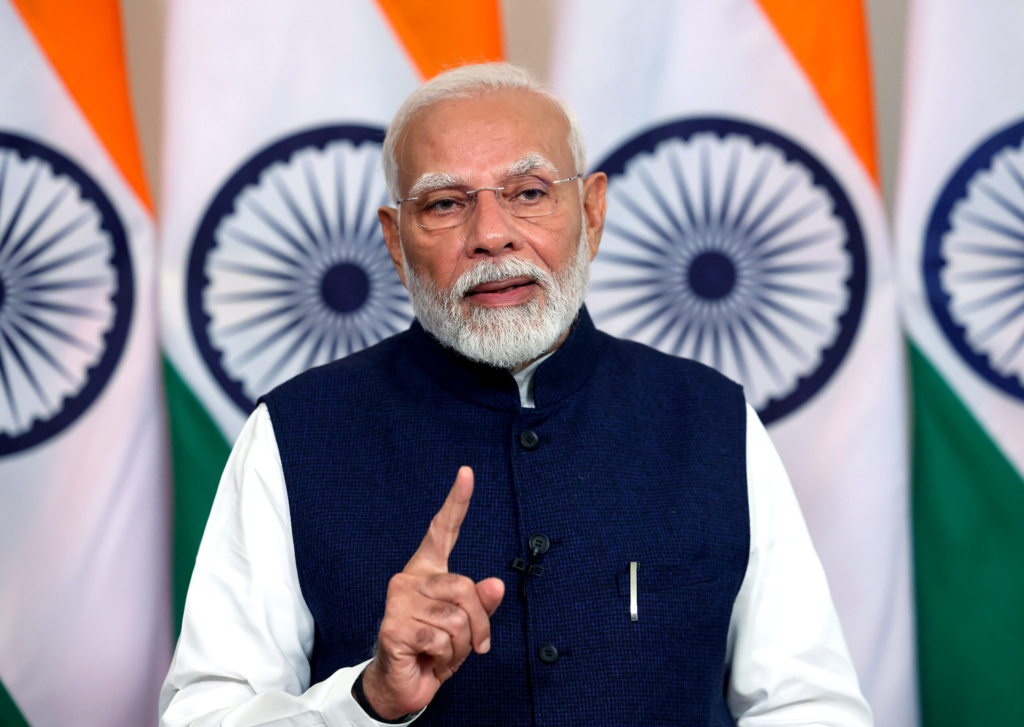
Strategic Objective: Dismantle the Terror Ecosystem
India’s goals with Operation Sindoor were clear, limited, and brutally effective:
- Target and destroy Pakistan-based terror camps in Bahawalpur, Muzaffarabad, and Muridke—all known hubs of JeM and LeT operations.
- Avoid Pakistani civilian and military installations to prevent full-scale war, demonstrating India’s restraint.
- Deploy stand-off weapons to eliminate threats without risking pilot lives or violating airspace—a modern, calculated approach to punitive deterrence.
- Send an unmistakable message: The days of Pakistan using terrorism as a low-cost war strategy are over.
This wasn’t an impulsive retaliatory strike. It was an orchestrated, multi-layered military operation, executed with strategic patience, real-time intelligence, and operational superiority.
Key Characteristics of Operation Sindoor
- ✅ Precision strikes using Rafale jets and BrahMos missiles—all launched from Indian territory.
- ✅ Zero civilian casualties in India’s target list—a sharp contrast to Pakistan’s indiscriminate shelling of Indian border towns.
- ✅ Integration of AI-powered drones and loitering munitions—targeting radar systems and communication nodes inside Pakistan.
- ✅ Real-time ISR (Intelligence, Surveillance, Reconnaissance) via satellites and drone footage.
- ✅ No ground troop incursion—India had no interest in escalation, only in exacting punishment for terrorism.

Why Now? Why This Time?
What made Operation Sindoor fundamentally different from previous Indian responses like the 2016 Surgical Strikes or 2019 Balakot Air Strikes was the scale and context.
- Public patience had run out. The massacre of unarmed civilians at Pahalgam crossed all moral boundaries.
- Strategic tools were ready. With Rafales, SCALP missiles, Israeli drones, and S-400 systems operational, India now had the tools to inflict punishment without risk.
- Global optics had shifted. After the chaotic U.S. withdrawal from Afghanistan, even Washington couldn’t deny Pakistan’s duplicity any longer.
- China’s growing footprint in Pakistan was seen as a geostrategic cover for anti-India operations, adding urgency to dismantle proxy terror camps.
This was not a gamble—it was calibrated coercion, executed under clear political will, and supported by multi-domain military superiority.
Operation Sindoor was India telling the world:
“We do not seek conflict, but if you export terror, you import destruction.”
Timeline of Major Events (May 6–10, 2025)
The execution of Operation Sindoor and the subsequent escalation between India and Pakistan unfolded over five critical days. What began as a swift and precise anti-terror operation by India soon revealed Pakistan’s deep entanglement with terrorist networks, China’s behind-the-scenes enablement, and America’s inconsistent stance.
Below is a day-by-day breakdown of the most decisive days in South Asia’s recent history.
🇮🇳 May 6, 2025 – The Operation Begins
✅ 03:30 AM IST: India launches Operation Sindoor.
- Indian Air Force Rafale jets, equipped with SCALP air-launched cruise missiles, strike nine confirmed terror targets in Bahawalpur, Muridke, and Muzaffarabad—hotbeds of JeM and LeT activity.
- All strikes are executed from within Indian airspace, thanks to the long-range precision of stand-off weapons.
- India uses loitering munitions and BrahMos missiles to hit infrastructure without entering enemy territory.

🎯 Key Targets Hit:
- JeM’s Bahawalpur headquarters: reportedly obliterated.
- LeT’s ideological and logistics hub in Muridke: crippled.
- Three training camps in PoK near Kotli and Muzaffarabad: flattened.
🔴 Result: Over 100 terrorists eliminated, including top JeM commander Abdul Rauf Azhar (brother of Masood Azhar). Pakistan scrambles to contain the fallout, but denies any damage.
May 7, 2025 – Pakistan Retaliates with Lies and Chaos
🛑 Morning: Pakistan’s Air Force launches retaliatory air operations along the LoC.
- Pakistani J-10C fighters (Chinese supplied) engage Indian jets in aerial skirmishes.
- Pakistan claims to have downed 3 Indian jets, including a Rafale—no evidence provided.
- India does not confirm losses, maintaining focus on neutralizing new threats across the LoC.

💣 LoC Shelling Escalates:
- Pakistan targets Indian civilian zones—Kupwara, Poonch, and Baramulla face heavy shelling.
- Indian Army responds with pinpoint artillery, targeting only militant camps and Pakistani launch pads.
🎭 Propaganda Begins:
- Pakistan falsely claims Indian strikes hit civilians and a mosque. Later satellite images show terror facilities disguised as religious sites.
🟡 India’s Stance: “We struck only confirmed terror targets. Civilians are victims of Pakistan’s reckless defense of terrorists.”
🛰️ May 8, 2025 – Drone Warfare & False Flag Claims
🚨 Night Assault on Indian Cities:
- Armed drones and possible missile salvos target Amritsar and New Delhi outskirts.
- India activates the S-400 air defense system, intercepts all incoming threats—a first in Indian combat history.

🛑 Pakistan Denies Involvement, then contradicts itself hours later by claiming “right to respond.”
🎯 India’s Next Strike:
- Loitering munitions disable a Pakistani radar station near Lahore.
- Drone swarms blind radar in Pakistani Punjab—neutralizing Pakistani air defenses temporarily.
📉 Pakistani Losses:
- 12 Indian drones claimed downed—India confirms only one lost, others completed missions.
- Indian drone hits PAF base in Lahore, reportedly destroying logistics depot.
🎙️ Pakistani Disinformation:
- Pakistan claims India bombed a cricket stadium in Rawalpindi—later proven false by journalists.
⚠️ China’s Shadow: Many drones attacking India are Turkish-built but Chinese-funded and supplied under joint contracts. China’s weapons exports to Pakistan finally seen not as defense, but as indirect support for terrorism.
🚀 May 9, 2025 – Conflict Widens, Ceasefire Talks Begin
📍 Morning: Pakistan expands attacks beyond LoC. Drones strike targets in Rajasthan and Punjab, including civilian zones in Firozpur and Bikaner.
- India retaliates with deep penetration drone strikes, knocking out a Pakistani early-warning system in Jacobabad.
- Pakistani shells kill the Jammu City Commissioner and his family—clear civilian targeting.
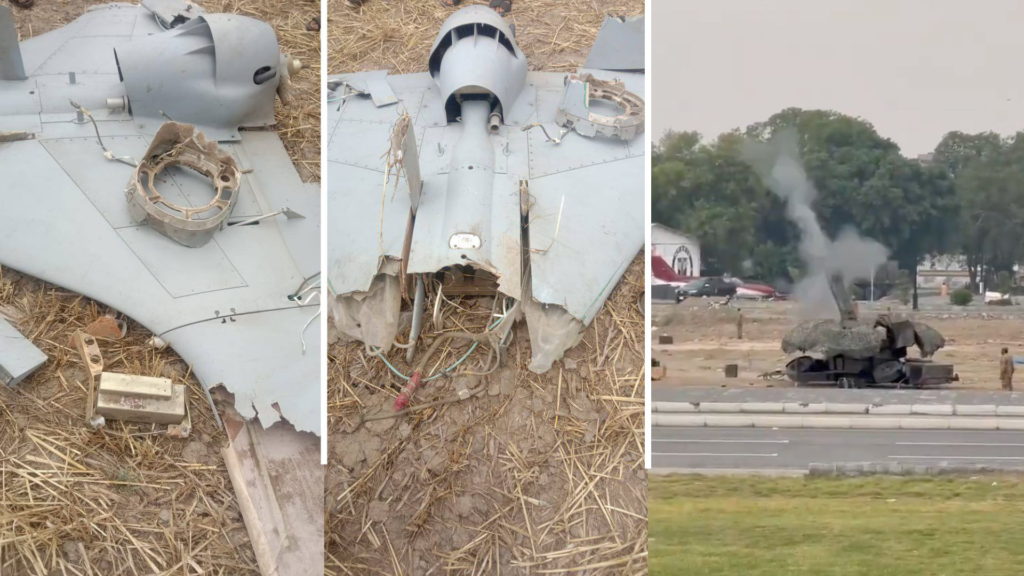
💣 Religious Sites Targeted:
- India accuses Pakistan of striking a Hindu temple in Jammu—a war crime under international law.
🕵️ Pakistan’s Psychological Warfare:
- Spreads fake news about Indian attacks on Sikh sites in Pakistan, aiming to inflame India’s Sikh community—India’s intelligence intercepts prove it was a planned ISI operation.
📞 Diplomatic Front Activates:
- US, UAE, and Saudi Arabia push for de-escalation.
- India agrees to ceasefire only if Pakistan halts all terror support immediately.
🕊️ May 10, 2025 – Final Strikes & Ceasefire
🔥 Pre-Dawn Strikes by India:
- India fires 5 surface-to-surface missiles from Srinagar at:
- Nur Khan Airbase (Rawalpindi)
- Shahbaz Base (Jacobabad)
- Terror camps near Islamabad suburbs
- Nur Khan Airbase (Rawalpindi)

🚫 Pakistan’s Last Gasp – Operation Bunyan al-Marsus:
- Pakistan fires Fatah-II guided rocket toward New Delhi—intercepted by India’s S-400 system before reaching Haryana.
- Also launches cyber-attacks on Indian websites—traced back to ISI-linked servers in Beijing and Rawalpindi.
⚰️ Final Civilian Toll:
- A total of 15 Indian civilians killed, 31 Pakistani civilians, and 100+ terrorists neutralized.
🕔 5:00 PM IST – Ceasefire Declared
- Mediated by US and Gulf nations
- Announced by President Trump on X (formerly Twitter) before either government did.
🟨 Pakistan Declares “Victory” with no gains, heavy damage, and global embarrassment.
🟩 India Ends Operation Sindoor, having:
- Eliminated top terror leadership
- Destroyed infrastructure used to launch attacks on Indian soil
- Demonstrated restraint and strategic superiority
Summary of Outcomes
| Date | India’s Actions | Pakistan’s Response | Result |
| May 6 | Launched air/missile strikes | Denial + media spin | 100+ terrorists killed |
| May 7 | Engaged in aerial skirmish | Claimed Rafale kills | Loss of credibility |
| May 8 | Drone warfare escalates | Drone & missile attacks on India | India’s S-400 intercepts |
| May 9 | Hits key radar sites | Shells civilians, false flags | Diplomatic pressure mounts |
| May 10 | Final strikes near Islamabad | Cyber-attacks & ceasefire talks | Ceasefire agreed under pressure |
Verdict:
Operation Sindoor showed the world that India will no longer play by Pakistan’s rigged rules, nor tolerate terrorism protected by Beijing and excused by Washington. This five-day conflict exposed Pakistan’s lies, discredited its propaganda, and delivered justice to the victims of the Pahalgam massacre.

Military Strategy and Tactics
Operation Sindoor wasn’t just about sending a message. It was a masterclass in modern, multi-domain warfare, reflecting India’s evolution from a reactive posture to a proactive doctrine of targeted deterrence. From high-altitude airstrikes to drone swarms and cyber defense, India deployed every tool short of a full-scale invasion. In contrast, Pakistan’s retaliation revealed a fractured, outdated military doctrine heavily dependent on non-state actors and foreign support.
🎯 India’s Strategy: Precision, Containment, and Escalation Control
The Indian Armed Forces approached Operation Sindoor with surgical precision and strategic maturity, keeping the objective clear: decimate the terror infrastructure while avoiding a conventional war.
Key Pillars of India’s Strategy:
- ✅ Stand-Off Strikes:
India employed SCALP cruise missiles and Hammer glide bombs launched from Rafale jets—all fired from within Indian airspace.
→ Result: Deep penetration without risking pilots or triggering airspace violations. - ✅ No Ground Incursion:
Unlike 2016’s surgical strikes, Operation Sindoor avoided crossing the LoC. India maintained moral and legal high ground, leaving Pakistan with no justification for escalation. - ✅ Drone Dominance:
India deployed Israeli-made Harop loitering munitions, SkyStriker kamikaze drones, and AI-coordinated swarms to:
- Disable Pakistani radar and surface-to-air missile systems
- Conduct SEAD (Suppression of Enemy Air Defenses) missions deep inside Pakistani airspace
- Target logistic nodes used by terror groups under military protection
- Disable Pakistani radar and surface-to-air missile systems
- ✅ Layered Air Defense:
India’s S-400 Triumf air defense system—recently operational—was battle-tested during this conflict.
- Intercepted incoming Pakistani drones, rockets, and a Fatah-II missile aimed at New Delhi
- Marked India’s first successful ballistic missile defense in a live conflict scenario
- Intercepted incoming Pakistani drones, rockets, and a Fatah-II missile aimed at New Delhi
- ✅ Real-Time ISR Integration:
India used satellite surveillance, AWACS (Airborne Warning and Control Systems), and drone reconnaissance to guide every strike with live battlefield intelligence.
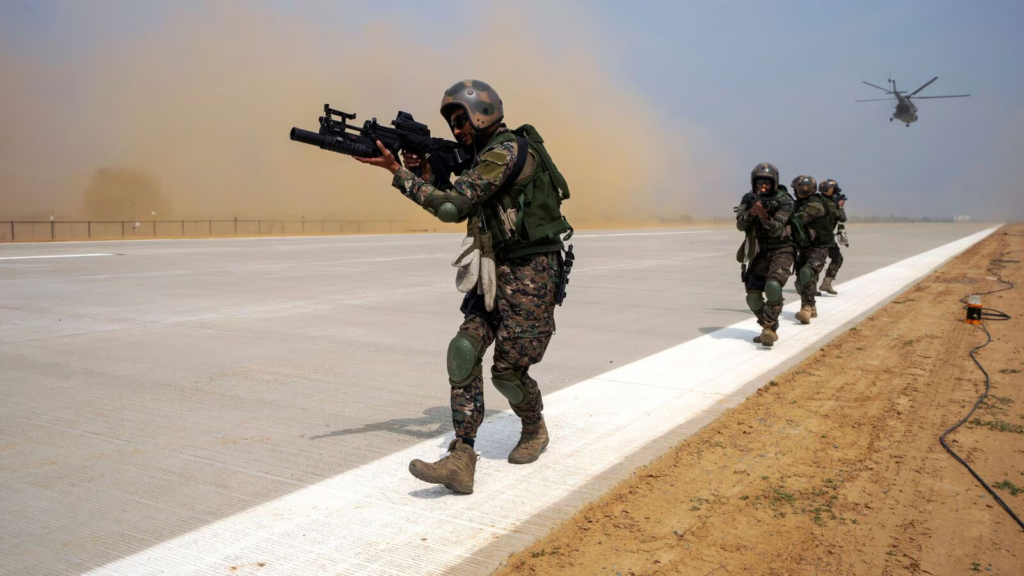
“Not a bullet was fired without 360° visibility. This was a networked battlefield.” — Indian Air Force Commander, May 11, 2025
💥 Pakistan’s Tactics: Retaliation by Proxy, Backed by Beijing
While India relied on state-of-the-art systems and doctrine-driven precision, Pakistan leaned on its old playbook: asymmetric warfare, terror proxies, and media manipulation.
Exposed Pakistani Doctrine:
- ❌ Blind Retaliation:
Pakistan’s counterstrikes lacked focus. Instead of hitting military targets, they shelled Indian civilian areas and launched drones at cities like Amritsar, risking international condemnation. - ❌ Civilian Infrastructure as Shields:
Indian satellites revealed that JeM and LeT camps were camouflaged as schools, mosques, and community centers, deliberately endangering civilians to exploit potential collateral damage. - ❌ China-Backed Drone Warfare:
Most of Pakistan’s drone inventory, including the Songar quadcopters and CH-4s, were either Chinese-made or jointly developed with Chinese funding.
- These drones were used not for reconnaissance, but to target Indian civilian zones—a clear violation of the laws of armed conflict.
- These drones were used not for reconnaissance, but to target Indian civilian zones—a clear violation of the laws of armed conflict.
- ❌ Uncoordinated Air Defense:
Despite aggressive rhetoric, Pakistan’s air defenses failed to prevent Indian drones from disabling key radar sites near Lahore and Jacobabad.
→ India exposed blind spots in Pakistani early-warning systems, causing panic in Rawalpindi. - ❌ Terror Infrastructure Integration:
Pakistan’s military provided logistical cover to terror organizations. Satellite imaging showed movement between army bases and JeM camps, proving that terrorism and military policy in Pakistan are two sides of the same coin.

🔍 India’s Restraint vs Pakistan’s Recklessness
| Dimension | India (Operation Sindoor) | Pakistan (Bunyan al-Marsus) |
| Targeting Strategy | Terrorist camps only, no civilians or military bases | Civilian areas, random shelling, unverified missile attacks |
| Airspace Discipline | No entry into Pakistani airspace | Violated Indian airspace with drones, rockets |
| Precision | GPS-guided munitions, confirmed targets via ISR | Inaccurate drone strikes, many intercepted or misfired |
| Command Structure | Unified under civilian and military leadership | Fragmented; military and ISPR often contradicted each other |
| Tech Dependence | Indigenous + allied systems (Israel, France) | Reliant on Chinese drones, missiles, radar |
🔻 Pakistan’s Strategic Miscalculation
Pakistan assumed India’s response would follow old patterns: symbolic retaliation, media noise, and international de-escalation. Instead, it was hit by:
- Multi-axis drone strikes
- Air-defense suppression
- Long-range missile precision
- Global diplomatic isolation
Worse still, by responding with civilian-targeted drone swarms, Pakistan not only violated international humanitarian law but also proved India’s claims that Pakistan is incapable of separating terrorism from military doctrine.
“Pakistan didn’t just lose face militarily. It lost the last sliver of deniability it had left.” — Indian strategic analyst, IDSA
The Air Battles – Who Controlled the Skies?
When the skies over Kashmir lit up on May 7, 2025, the world braced for a dangerous escalation between two nuclear-armed neighbors. While Operation Sindoor was launched with the intent of avoiding a broader war, Pakistan’s reckless and ill-prepared response pushed the conflict into the first major air combat between India and Pakistan in decades.
And yet, contrary to Islamabad’s propaganda machine, the battle for air superiority was not one of parity—it was a tactical victory for India’s doctrine-driven, precision-led Air Force, even amid a few hard lessons.

✈️ India’s Air Power: Controlled, Purpose-Driven, Decisive
The Indian Air Force (IAF), guided by strict operational directives, kept its engagements defensive, coordinated, and non-escalatory. Despite provocations, it focused entirely on achieving three core goals:
- Deter Pakistani Air Force incursions
- Maintain dominance over Indian airspace and the LoC
- Protect strategic targets and civilian populations
✅ Rafales in Action
- Rafale multirole fighters, India’s latest acquisitions from France, formed the backbone of air operations.
- Equipped with Meteor air-to-air missiles, Spectra jamming systems, and SCALP missiles, they operated primarily from forward bases in Ambala and Srinagar.
- Their job was not to dogfight recklessly but to enforce aerial deterrence—a role they performed with clinical precision.
✅ S-400 Triumphs
- India’s S-400 Triumf missile defense system—acquired from Russia—was activated to full readiness.
- Intercepted multiple drones and a Fatah-II missile launched toward New Delhi and Punjab.
- Demonstrated India’s layered air defense capability, setting a regional precedent.
“Air superiority is not just about shooting down enemy aircraft. It’s about denying the enemy their strategic intent. India did just that.”
— Retd. Air Marshal R.K. Bhadauria
🛑 Pakistan’s Air Force: Chinese-Made Hype, Fragile Capability
The Pakistan Air Force (PAF) made bold claims in its press briefings, but beneath the surface, it was a high-decibel, low-delivery force, dependent almost entirely on Chinese hand-me-downs and incapable of strategic initiative.
❌ Dubious Kill Claims
- Pakistan claimed to have downed three Indian jets, including a Rafale, a MiG-29, and a Su-30MKI.
- No wreckage of Rafales was ever recovered. The IAF did not confirm any such losses.
- Independent analysts believe only one MiG-29 was potentially downed, likely due to a Chinese-supplied PL-15 missile, which raises serious questions about China’s proxy engagement.
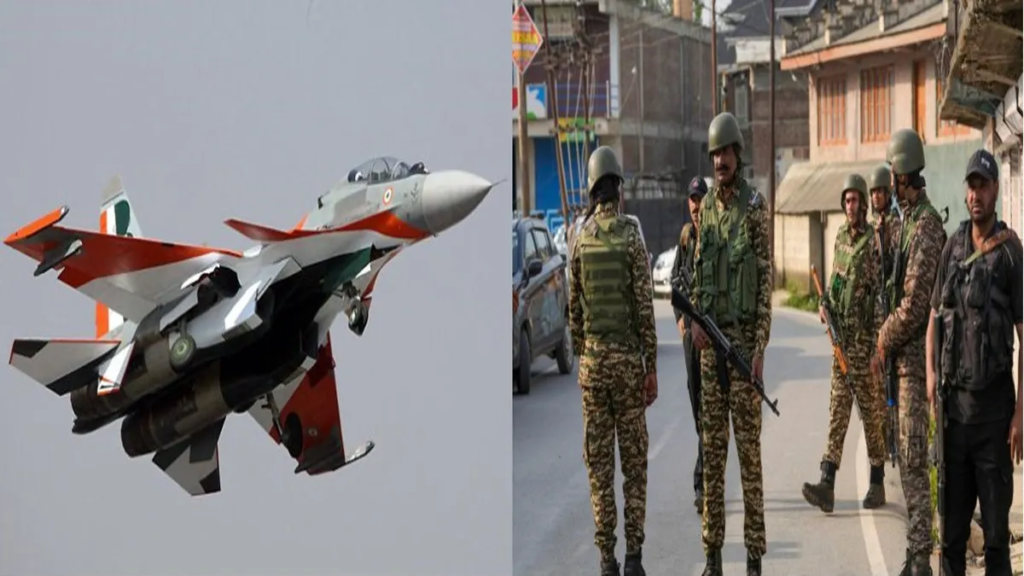
⚠️ Irony: A country that denies hosting terror camps wants the world to believe it hit a stealth-capable, Spectra-equipped Rafale?
❌ Dependency on Beijing
- Pakistan’s PAF relied heavily on Chinese-made J-10C fighters, recently acquired in 2022–24 under emergency funding from Beijing.
- These jets used PL-15 beyond-visual-range missiles, often with Chinese tactical advisors involved in field operations.
- Chinese-supplied radar systems and data-link jammers failed to detect Indian drones during SEAD missions—exposing Beijing’s tech as sub-par when used against advanced adversaries.
❌ No Air Superiority Doctrine
- Pakistan’s approach to air defense was reactive and fragmented.
- Instead of building a layered air denial system, PAF scrambled fighters after Indian strikes, often guided by panicked ground-based radar.
- In contrast, India had pre-coordinated no-fly zones, decoy paths, and aerial surveillance tied directly to battlefield decisions.
📉 The Fog of War – Propaganda vs Reality
Pakistan’s Inter-Services Public Relations (ISPR) repeatedly broadcasted inflated victories—including fake cockpit footage, recycled videos from 2019, and dramatic audio clips of “Indian pilots panicking.” However:

- Independent satellite analysis by Maxar Technologies confirmed no major Indian aircraft losses over Pakistani territory.
- U.S. intelligence sources, speaking off record to Reuters, debunked PAF’s Rafale kill claim, acknowledging only one Indian aircraft potentially hit.
Meanwhile, India refrained from theatrics. No wild claims. No victory parades. Just cold, operational reporting.
🧠 Strategic Lessons from the Air Skirmishes
India’s Gains:
- ✅ Validated the Rafale’s ability to conduct deep-strike missions without crossing borders
- ✅ Successfully integrated air superiority with ground ISR and drone warfare
- ✅ Demonstrated a mature, policy-bound military posture in the face of provocation
Pakistan’s Exposures:
- ❌ Overreliance on Chinese equipment with unproven battlefield integration
- ❌ Lack of real-time coordination between ground and air commands
- ❌ Use of propaganda as a substitute for actual battlefield success
“Pakistan didn’t win air dominance. They lost narrative dominance and exposed their overdependence on foreign tech and lies.”
— Indian Defense Analyst, ORF
🧨 U.S. and Chinese Duplicity in the Skies
Let’s not ignore the enablers behind Pakistan’s misplaced confidence:
- China’s role went beyond mere arms supply. Chinese “technical advisors” were allegedly present during PAF J-10C deployments and radar re-calibrations—a blatant violation of neutrality.
- The United States, while calling for de-escalation, continued its non-lethal military aid pipeline to Pakistan, turning a blind eye to how its taxpayer dollars end up subsidizing an air force defending terror safe havens.
India flew its own planes, used its own weapons, and stood by its own intelligence.
Pakistan borrowed jets, relied on Chinese radars, and hid behind disinformation.
The Drone War – A First in South Asia
The May 2025 conflict between India and Pakistan wasn’t just a border skirmish—it marked the region’s entry into the era of autonomous, AI-enabled warfare. Operation Sindoor will be remembered as South Asia’s first large-scale drone war, where unmanned systems were no longer fringe assets, but core instruments of strategy.

🔧 The Battlefield Has Changed Forever
For decades, drones were considered secondary tools—useful for surveillance, maybe precision kills. But during Operation Sindoor, they became force multipliers, missile escorts, target neutralizers, and most importantly, deterrence enforcers.
This was no longer a war of boots on the ground or dogfights in the air.
This was a war of swarms, AI, radar evasion, and electronic dominance.
India’s Drone Doctrine: Precision Over Provocation
India’s drone warfare strategy was built around three principles:
- High-value target elimination
- Radar suppression and SEAD (Suppression of Enemy Air Defenses)
- No collateral damage
🔹 Systems Used:
- Harop Loitering Munitions (Israel)
Suicide drones used to strike enemy radar and communication hubs—first deployed deep inside Pakistani Punjab. - SkyStriker Drones (Israel)
Small, fast, GPS-guided drones used to take out JeM weapons storage and control rooms. - Quadcopters with thermobaric payloads
Used for close-range destruction of bunkers and caves in PoK’s hilly terrain. - AI-coordinated swarms
Indian drone units worked in synchronized formations, with support from airborne EW platforms, ensuring minimal radar footprint.
🔍 Results:
- Knocked out Pakistani radar near Lahore, blinding their ability to track incoming aircraft.
- Destroyed two LeT camps near Kotli and Bhimber without a single civilian casualty.
- Penetrated Pakistani airspace below radar, with real-time ISR support from Indian satellites.
“We didn’t drop payloads blindly. We surgically removed the cancer Pakistan was feeding for decades.”
— Senior Indian Army Officer, Drone Operations Command
Pakistan’s Drone Tactics: Reckless, Random, and China-Fueled
Unlike India, Pakistan used drones like a desperate man throwing stones in the dark—not for strategy, but symbolism.

🔻 What They Deployed:
- Songar Armed Drones (Turkey-China collaboration)
Modified quadcopters with grenade payloads—used to strike Indian civilian areas, violating all conventions of proportional warfare. - CH-4 UAVs (Chinese drones)
Long-range drones for surveillance and air strikes—operated with advisory support from Chinese engineers stationed at PAF bases. - Commercial drones with crude IEDs
Launched from PoK and Punjab into Indian border villages.
💥 What They Hit:
- Civilian targets in Amritsar, Firozpur, and Jammu—killing families, damaging temples, and injuring children.
- Tried (and failed) to penetrate India’s defenses around Delhi—intercepted by S-400s.
- Lost dozens of drones to anti-drone rifles and jamming systems deployed by Indian Special Forces in border sectors.
“Pakistan used Chinese-supplied drones to bomb temples and schools. Let that sink in.”
— Indian External Affairs Ministry Spokesperson
🧪 The Technology Gap: India’s Advantage vs Pakistan’s Dependency
| Category | India | Pakistan |
| Drone Origin | Israeli, indigenous | Chinese, Turkish |
| Guidance & Targeting | AI-coordinated, GPS + ISR integrated | Manually guided, GPS-spoofing prone |
| Use of Swarms | Yes (SEAD + surveillance clusters) | No effective swarm logic |
| Civilian Target Avoidance | Strict protocols in place | No distinction—deliberate strikes on civilians |
| Combat Effectiveness | High—targeted, successful, precise | Low—most drones intercepted or misfired |
🌐 China’s Hand in the Drone War
China didn’t launch missiles—but its hardware, training, and advisors were embedded in Pakistan’s drone deployment:
- CH-4 drones operated with PLA-trained personnel.
- AI software used in Pakistani drone swarm attempts was developed by Chinese firms, allegedly dual-use projects tied to military applications.
- Electronic jamming used to disrupt Indian comms in Punjab was traced to Chinese-modified EW systems.
This wasn’t Pakistan vs India—it was terrorism enabled by Chinese tech vs sovereignty protected by Indian strategy.
“China armed the hand that bombed Indian civilians. They weren’t bystanders. They were enablers.”
— Indian Intelligence Brief, May 2025

🧠 Lessons for the Future: Drone Wars Are Here to Stay
- India is now accelerating its indigenous drone production under “Project Trinetra” to ensure independence from foreign suppliers.
- Border zones will see automated drone kill-boxes, counter-swarm radar, and autonomous perimeter defense systems.
- Pakistan, having failed to breach India’s layered drone defense, is now reportedly seeking more advanced swarms from China and Iran—a move that will only increase global scrutiny of its terror ecosystem.
Pakistan’s Response – Operation Bunyan al-Marsus
In retaliation to India’s precise and controlled Operation Sindoor, Pakistan launched its counteroffensive on May 10, 2025, under the codename Operation Bunyan al-Marsus—Arabic for “The Wall of Solid Lead.” But behind the grandiose name and fiery rhetoric, the operation turned out to be a knee-jerk, scattershot reaction driven more by optics than strategy.
Instead of targeting Indian military assets, Pakistan unleashed a barrage of drones, missiles, and propaganda, hitting civilian centers and religious sites while clinging to the false narrative of “self-defense.” In truth, Bunyan al-Marsus exposed the very fragility of Pakistan’s military doctrine, its dependency on foreign tech, and its preference for escalation through deception.
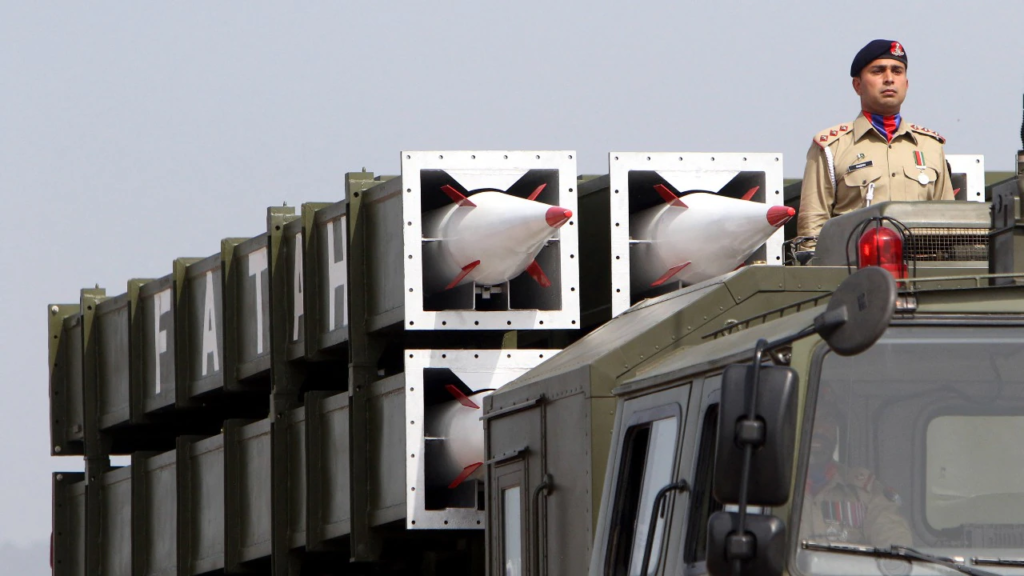
🪧 Why the Name “Bunyan al-Marsus”?
Pakistan’s military elite chose the name to evoke religious strength and resolve, drawing on Quranic imagery.
But in practice, it was a public relations stunt designed to:
- Mobilize domestic support through religious symbolism
- Create parity with India’s Operation Sindoor in media optics
- Mask the lack of clear strategic goals
“They gave it an Arabic name to project Islamic unity, but all they projected was insecurity and recklessness.”
— Pakistani Defense Analyst (anonymous), post-ceasefire
💥 What Did Pakistan Actually Do?
🔻 1. Missile and Drone Strikes on Indian Cities
- Targeted Amritsar, Jammu, Jaisalmer, and Firozpur using a mix of armed drones and Fatah-II guided artillery rockets.
- One missile aimed at New Delhi was intercepted by the Indian S-400 system over Haryana.
- Drones breached border regions, some crashing in Punjab’s villages and injuring civilians—not a single military installation was hit.
🛑 Clear War Crimes:
- Pakistani drones deliberately targeted a Hindu temple in Jammu and a school in Poonch district.
- A drone exploded in Firozpur, maiming a farming family in broad daylight.
🔻 2. Propaganda Offensive
- Accused India of hitting the Gurdwara Janam Asthan in Pakistan—a claim later debunked by satellite imagery and Sikh community leaders.
- Released fake cockpit videos and audio leaks, supposedly of Indian pilots, which were exposed as doctored or recycled from earlier years.
🔻 3. Cyber Attacks
- Attempted defacements of Indian websites:
- Indian Army’s portal
- BJP’s official site
- Border Security Force’s communication servers
- Indian Army’s portal
- The attack signatures were traced back to Beijing-hosted proxy servers and Pakistani military IPs—clear collaboration between ISI and Chinese cyber units.

“Pakistan’s cyber offensive had Chinese fingerprints all over it. Their malware payloads matched earlier attacks on Indian satellites in 2023.”
— Indian Cyber Command Briefing
🤖 The Role of Chinese Technology in Pakistan’s Response
Once again, Pakistan didn’t retaliate alone. Its response was heavily supported by Chinese weapon systems, advisory input, and back-end logistics.
🧩 Chinese Involvement:
- Fatah-II missile used in the strike on Delhi was jointly developed with Chinese engineers under the Al-Khalid Strategic Project.
- Drone swarm algorithms were reportedly imported from China’s PLA research labs.
- Chinese advisors were present at PAF bases in Sargodha and Mianwali during the air defense mobilizations.
“Without China’s technological leash, Pakistan wouldn’t even be able to launch a second wave of retaliation. Beijing pulled the strings behind the curtain.”
— Indian Military Attaché, Post-Conflict Review
📉 Tactical Outcomes: More Noise Than Impact
Pakistan declared Bunyan al-Marsus a “historic success.” But what was actually achieved?
| Objective | Outcome |
| Cripple Indian defenses | ❌ Failed – India’s S-400 neutralized threats |
| Deter further Indian action | ❌ Failed – India continued strikes until ceasefire |
| Boost domestic morale | ⚠️ Partial – brief spike, but ended in public disillusionment |
| Win global sympathy | ❌ Failed – international media exposed civilian targeting |
Even Pakistan’s civilian population began to question the value of a response that brought retaliatory fire to their doorsteps without any measurable military success.
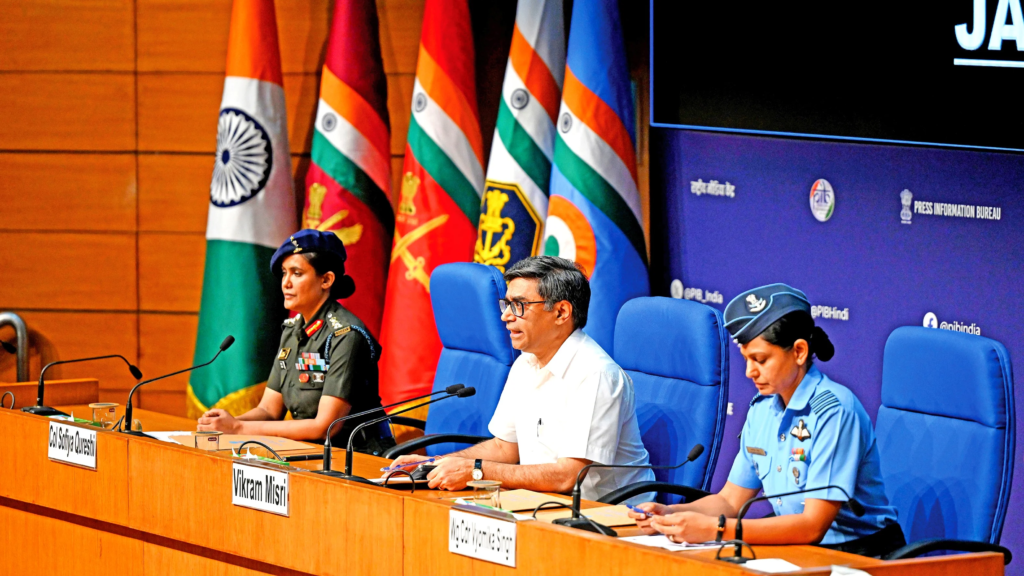
🏳️ The Diplomatic Fallout
While missiles flew, Pakistan ran to the UN, playing victim yet again. However:
- Global powers saw through the act. The United Nations, EU, and ASEAN bloc refused to condemn India.
- Only Turkey, Iran, and Qatar offered muted statements of “solidarity”—but none supported Pakistan’s version of events.
- Even China, while actively supporting militarily, remained silent diplomatically, exposing the duplicity of its regional policy—arming one side while pretending to be neutral.
“China lets Pakistan burn, then offers a bucket of water. That’s not neutrality—it’s manipulation.”
— Indian Diplomatic Advisor
🧨 Summary: Operation Bunyan al-Marsus Was…
- A reaction, not a plan
- A media show, not a military achievement
- A Chinese-assisted attempt to save face, not sovereignty
- A reminder that Pakistan’s military doctrine still prioritizes optics over outcome
Cyber Warfare and Psychological Ops
While missiles and drones dominated headlines during Operation Sindoor, an equally dangerous front was unfolding behind the scenes: cyber warfare and information manipulation. As India’s missiles struck terrorist infrastructure with precision, Pakistan activated its second most dependable weapon after terrorism—disinformation.
Through a series of cyberattacks, deep fakes, false-flag claims, and AI-enhanced propaganda, Pakistan launched a coordinated effort to control the narrative, confuse global audiences, and galvanize domestic sentiment. And it didn’t act alone. Chinese digital infrastructure, known for its track record in surveillance and cyber-espionage, played a silent but critical role in enabling these tactics.

🕸️ Pakistan’s Disinformation Doctrine
The Pakistani military’s Inter-Services Public Relations (ISPR) department has long functioned more as a propaganda agency than a press office. But during this conflict, it operated at full throttle.
📣 Psychological Operations (PSYOPS) Tactics:
- Fake Indian pilot communications were broadcast, claiming panic in the IAF ranks.
→ Later debunked by Indian media as digitally altered 2019 Balakot recordings. - Fabricated visuals of bombed-out mosques and civilian homes were released.
→ Geolocation revealed they were from Yemen and Syria. - False claims that India struck the Gurdwara Janam Asthan in Nankana Sahib, aimed at inciting unrest among Indian Sikhs.
→ Sikh religious bodies in India and abroad confirmed no damage, and exposed the lie. - Fake casualty numbers were disseminated, alleging “hundreds” of Indian soldiers dead.
→ Even Pakistan’s civilian agencies contradicted these inflated numbers days later.
“Pakistan was at war with facts, not with the Indian military.”
— Indian Army Public Information Officer
💻 Coordinated Cyber Strikes
As psychological manipulation escalated, Pakistan’s ISI-backed cyber units launched targeted cyberattacks on Indian digital infrastructure.
❌ Attempted Targets:
- Indian Army’s logistics portal
- Border Security Force internal communication lines
- Official website of the ruling BJP
- Two Indian satellite uplink stations in Andhra Pradesh and Gujarat

🔍 Key Findings:
- Indian cybersecurity experts traced the malware signatures to known Pakistani and Chinese cyber espionage units, including groups aligned with APT-36 (Transparent Tribe) and APT-41, a notorious Chinese state-sponsored hacking group.
- Attack vectors were launched from server farms based in Guangdong, China, and bounced through ISPs in Rawalpindi and Karachi.
- Zero-day exploits used in the attacks bore Chinese code libraries—a sign of PLA collaboration with Pakistani cyber teams.
“The digital front in this war revealed an ugly truth—Pakistan spreads lies, but it’s China that builds them.”
— CERT-IN Lead Analyst, May 2025
India’s Cyber Resilience and Counter-Disinformation
India anticipated Pakistan’s digital playbook. Over the last two years, India had quietly fortified its cyber command structure, establishing:
- The Defence Cyber Agency (DCA), tasked with digital perimeter defense.
- AI-backed threat monitoring systems, capable of anomaly detection in network traffic.
- Rapid response teams to isolate compromised nodes within minutes.
✅ India’s Counter-Measures:
- Neutralized all major attacks on military systems within hours.
- Released authenticated video evidence of Indian strike targets—undermining Pakistan’s civilian casualty claims.
- Partnered with global media watchdogs to fact-check and debunk viral falsehoods in real time.
- Monitored and flagged bot activity linked to Chinese disinformation farms amplifying Pakistani narratives on Twitter (now X).
🧠 The Strategic Use of AI and Deepfakes
While both nations employed artificial intelligence for battlefield management, Pakistan misused AI for deception.
- Deployed deepfake videos purporting to show Indian political leaders “confessing” to attacking civilians.
- Attempted to spoof voice communications of Indian commanders via intercepted VHF transmissions.
India’s signals intelligence (SIGINT) teams rapidly traced these to Pakistani spoofing stations in PoK and jammed further attempts.
“India fought not just a war of missiles, but a war of minds—and it won both.”
— Indian Air Vice Marshal (Cyber Strategy), May 2025
🌐 China’s Digital Fingerprints
China’s role was subtle but insidious.
- Its state-backed tech firms provided encryption-breaking software and data obfuscation tools to Pakistani agencies.
- Chinese platforms like WeChat and Tencent servers were used to coordinate disinformation bot networks.
- Satellite bandwidth leased by Pakistan from Chinese telecom constellations was likely used to maintain uplink during blackout zones created by Indian SEAD operations.
These actions reveal that China wasn’t a passive observer. It was the backend engine for Pakistan’s digital warfare.
Words Can Kill, But Facts Can Liberate
Pakistan treated misinformation as a weapon of war.
India treated information as a shield of truth.
Through robust cybersecurity, real-time evidence dissemination, and digital diplomacy, India exposed Pakistan’s psychological operations for what they were—desperate, unethical, and internationally condemned.
The Ceasefire Deal and How It Was Brokered
By May 10, 2025, after four days of sustained strikes, drone warfare, air battles, cyber operations, and mounting civilian and military casualties on the Pakistani side, Islamabad found itself outmaneuvered, outgunned, and out of options.
The same Pakistan that had started the week with boasts of retaliation and religious bravado now scrambled behind closed doors to seek a face-saving ceasefire. And ironically, it turned to the very countries—China and the United States—whose diplomatic shields and military aid had emboldened its aggression in the first place.

🕔 Ceasefire Timing and Announcement
- On May 10 at 5:00 PM IST, a ceasefire between India and Pakistan was officially declared.
- Surprisingly, the first public announcement came not from New Delhi or Islamabad, but from U.S. President Donald Trump via X (formerly Twitter):
“BREAKING: After marathon efforts, India and Pakistan have agreed to a FULL AND IMMEDIATE CEASEFIRE. Congratulations to both nations for using common sense and putting peace first.”
This was followed by official confirmations from:
- India’s Foreign Secretary Vikram Misri
- Pakistan’s Finance Minister Ishaq Dar (also serving as interim foreign minister)
🧠 How the Ceasefire Was Really Brokered
Despite Pakistan’s theatrics, the ceasefire wasn’t a diplomatic victory for both sides—it was a desperate exit for Islamabad, facing the collapse of its terror command, public panic, and further loss of military credibility.
💡 Key Players:
- United States:
- Used its influence over Pakistan’s military to push for restraint.
- Behind closed doors, issued a veiled threat of aid suspension if escalation continued.
- Coordinated with India through backchannel talks and intelligence briefings.
- Used its influence over Pakistan’s military to push for restraint.
- Saudi Arabia & UAE:
- Long-time economic lifelines for Pakistan, they warned Islamabad to de-escalate or face financial pullback.
- Offered to mediate future India-Pakistan talks in neutral venues.
- Long-time economic lifelines for Pakistan, they warned Islamabad to de-escalate or face financial pullback.
- China:
- Publicly silent, but privately urged Pakistan to step back, fearing damage to its CPEC infrastructure and global economic optics.
- Ironically, Beijing helped Pakistan build the weapons used in the conflict, then told them to stop using them.
- Publicly silent, but privately urged Pakistan to step back, fearing damage to its CPEC infrastructure and global economic optics.
“China lit the fire by arming Pakistan, then tried to look like the fireman. A classic Beijing maneuver.”
— Senior Indian Diplomat, South Block
📜 Terms of the Ceasefire
Although the exact terms were not released in full, credible diplomatic sources confirmed the following:
- Cessation of hostilities from 5:00 PM IST on May 10
- Commitment to no further air, drone, or missile activity across the LoC or international border
- Return to peacetime military postures within 72 hours
- Preliminary agreement for follow-up diplomatic talks in Oman on May 12
- Reopening of Pakistani airspace and deactivation of missile alert systems
Notably, India made no concessions—territorial, diplomatic, or military.
Pakistan agreed to the ceasefire under pressure and without leverage, despite trying to spin it as a “mutual de-escalation.”

📰 How India Managed the Messaging
India’s restraint was strategic. Despite military and media momentum, New Delhi:
- Avoided triumphalist rhetoric, keeping the focus on anti-terror objectives.
- Reiterated that no Pakistani civilians or military installations were targeted.
- Clarified that Operation Sindoor would resume immediately if cross-border terror restarted.
“India did not need to declare victory. The facts on the ground spoke louder than any statement.”
— Defense Minister Rajnath Singh
📉 Pakistan’s Desperate Damage Control
Post-ceasefire, Pakistan tried to control domestic backlash by:
- Declaring May 11 as “Yaum-e-Tashakur” (Day of Gratitude)—a theatrical attempt to portray survival as success.
- Parading photos of supposed Indian wreckage—many of which turned out to be photoshopped or misattributed.
- Launching social media campaigns claiming “India blinked first,” while simultaneously begging for IMF loan restructuring.
None of it worked.
- Pakistani journalists and analysts began asking hard questions about:
- The actual damage sustained.
- Why military facilities were bypassed by Indian strikes.
- The failure of drone defenses and China’s overhyped technology.
- The actual damage sustained.
🌎 Global Reaction to the Ceasefire
| Country/Bloc | Reaction | Interpretation |
| United States | Welcomed ceasefire; claimed credit | Acted only after Pakistan began to lose |
| China | Silent; urged “restraint” | Complicit in buildup, passive in resolution |
| Russia | Supported India’s “measured response” | Positioned as India’s strategic ally |
| European Union | Called for “lasting peace” | Refused to endorse Pakistan’s narrative |
| Middle East | Pressured Pakistan to halt | Focused on preventing regional instability |
Not a single major power publicly condemned India’s strikes—because nobody believed Pakistan’s denials anymore.
🧨 The Fragile Truce
Hours after the ceasefire:
- Explosions were reported in Srinagar—allegedly from Pakistani drones violating the truce.
- Indian officials warned of “immediate retaliation” if any more ceasefire breaches occurred.
Despite these hiccups, the truce held—not out of goodwill, but out of exhaustion and global scrutiny.
✅ Final Verdict
- India achieved its objectives militarily and retained moral superiority diplomatically.
- Pakistan, cornered and exposed, surrendered under the guise of peace.
- China, having armed one side and advised silence, lost credibility as a neutral actor.
- America, though helpful in ending the crisis, failed once again to call out Pakistan’s terrorism by name.
Bottom Line:
The ceasefire was not the result of “mutual understanding.” It was a diplomatic euphemism for Pakistan’s strategic retreat—a retreat enabled by the very powers that once encouraged its adventurism.
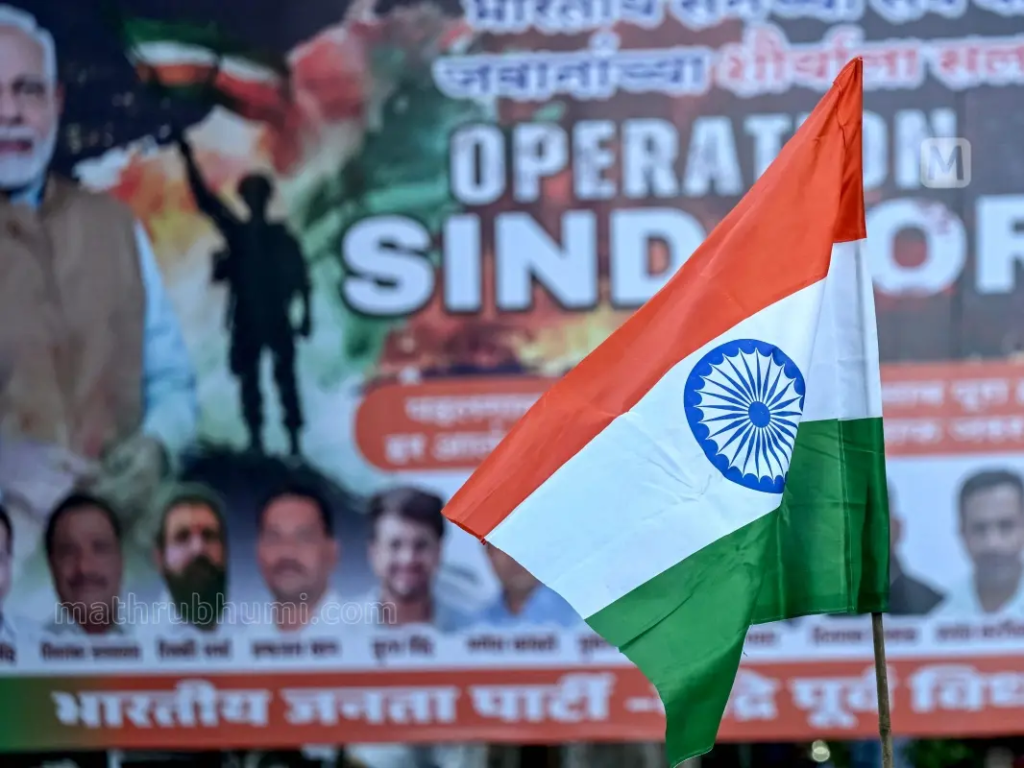
Civilian and Military Casualties
Every conflict has a human cost. But in the case of Operation Sindoor, the blood spilled told a very clear story—of discipline versus desperation, of surgical strikes versus indiscriminate fire, and of a military rooted in honor versus one hiding behind civilians.
India’s strikes were targeted, calibrated, and legally justified, aimed only at Pakistan-based terrorist infrastructure. In contrast, Pakistan’s response under Operation Bunyan al-Marsus was a cocktail of panic, propaganda, and poorly aimed violence—much of which directly harmed civilians on both sides of the border.
Civilian Casualties in Pakistan – Collateral or Cover?
Pakistan’s official narrative claimed that Indian missiles killed 31 civilians, including children. But a closer look tells a darker truth.
🧨 The Targets Were Terror Hubs
- Indian intelligence and satellite data confirmed that:
- The Bahawalpur complex bombed by India was JeM’s headquarters, not a school.
- The Muridke structure labeled as a “charity center” was, in fact, LeT’s weapons depot and ideological command post.
- Facilities in Muzaffarabad and Kotli were long known to house militant training camps.
- The Bahawalpur complex bombed by India was JeM’s headquarters, not a school.
“When you turn your mosques into bunkers and your schools into ammunition depots, civilian losses are not India’s burden—they are Pakistan’s sin.”
— Indian Defense Ministry Official
📉 Real Civilian Toll:
- Pakistan confirmed 31 civilian deaths, many of them family members of top JeM and LeT operatives—a fact inadvertently admitted by Masood Azhar himself, who mourned his nieces and nephews killed in the Bahawalpur strike.
- Additional 15–20 civilians were reportedly injured in PoK during retaliatory Indian artillery after Pakistani shelling targeted Indian border towns.
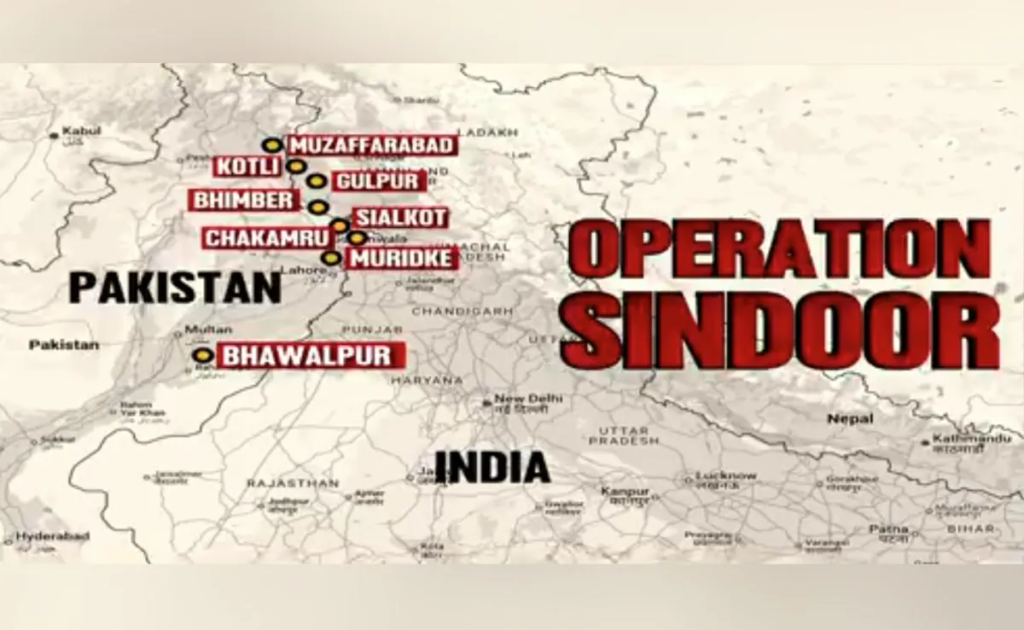
But the question remains: Were these truly “civilians”, or human shields planted in strategic locations, a familiar tactic used by terror outfits like JeM?
Civilian Casualties in India – Victims of Pakistan’s Panic
Unlike India, Pakistan never aimed for precision. Its drones and artillery targeted Indian border towns and religious landmarks, leading to tragic civilian losses.
☠️ Pakistan’s Attacks on Indian Civilians:
- Poonch District, Jammu & Kashmir:
- Pakistani drones dropped explosives near a school and gurdwara, killing 5 civilians, including two children.
- The Jammu City Commissioner and his family were also killed in a direct shell hit on their residence.
- Pakistani drones dropped explosives near a school and gurdwara, killing 5 civilians, including two children.
- Firozpur, Punjab:
- A Pakistani drone carrying shrapnel-based munitions exploded in a farmer’s field, killing a woman and injuring three children.
- A Pakistani drone carrying shrapnel-based munitions exploded in a farmer’s field, killing a woman and injuring three children.
- Jaisalmer, Rajasthan:
- One drone landed near a civilian water tower; though intercepted, falling debris caused injuries to nearby villagers.
- One drone landed near a civilian water tower; though intercepted, falling debris caused injuries to nearby villagers.
📌 Final Tally – Indian Side:
- 15 Indian civilians killed
- 43 civilians injured
- 6 Indian border villages damaged, including two schools and one temple
“This wasn’t war. It was blind rage. Pakistan couldn’t stop India in the skies, so it rained death on the ground.”
— Indian Home Minister briefing to Parliament

🪖 Military Casualties – Fact vs Fiction
✅ India’s Acknowledged Military Losses:
- 5 soldiers killed in various incidents:
- One IAF pilot presumed dead after a possible aircraft downing.
- One Army jawan killed during Pakistani shelling in Poonch.
- Three soldiers lost to drone impact and shrapnel injuries near LoC posts.
- One IAF pilot presumed dead after a possible aircraft downing.
- 6 aircraft damaged (3 minor, 1 confirmed crash, 2 under investigation).
India did not confirm the loss of a Rafale, despite Pakistani claims.
❌ Pakistan’s Military Losses (Underreported):
- Officially admitted:
- 1 Air Force officer (Squadron Leader Usman Yousaf) killed in a drone strike on the Bholari Air Base.
- 4 Army personnel injured in separate drone and missile incidents.
- 1 Air Force officer (Squadron Leader Usman Yousaf) killed in a drone strike on the Bholari Air Base.
- Unofficially reported:
- At least 10–15 Pakistani soldiers believed dead, including some stationed near Bahawalpur and Kotli.
- Indian estimates place Pakistan’s militant death toll at over 100, including JeM commander Abdul Rauf Azhar.
- At least 10–15 Pakistani soldiers believed dead, including some stationed near Bahawalpur and Kotli.
“Pakistan cries for civilians but won’t mourn the terrorists it lost. That tells you everything you need to know about their priorities.”
— Indian Army Intelligence Brief, May 2025
📊 Summary Table: Confirmed Casualties
| Category | India | Pakistan (Official) |
| Civilians Killed | 15 | 31 (many linked to terror ops) |
| Civilians Injured | 43 | 46 |
| Soldiers Killed | 5 | 1 (official), est. 10–15 (unofficial) |
| Known Terrorist Deaths | — | 100+ (including high-ranking) |
| Military Equipment Lost | 1–2 aircraft (under review) | Multiple radar sites, 2 drone bases, dozens of drones |
🔎 Final Analysis
- India’s strikes were surgical and justifiable, verified by satellite intelligence and global restraint.
- Pakistan’s casualties—civilian or militant—were the direct result of its own decision to embed terror infrastructure in residential zones.
- Pakistan’s attacks on Indian civilians and religious sites constituted war crimes, which are now being compiled into dossiers for international forums.
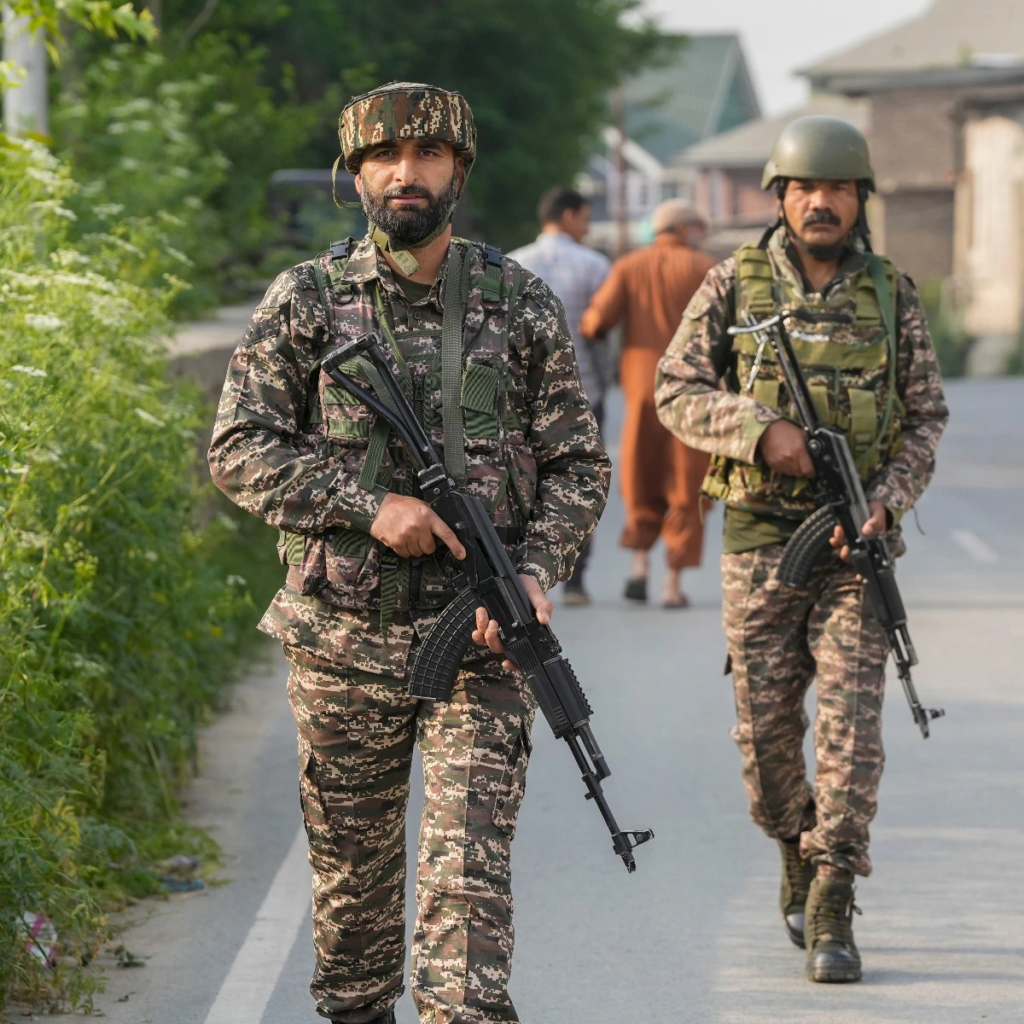
Humanitarian Impact on Both Sides
Wars are not only fought on battlefields. They’re fought in homes, shelters, hospitals, and refugee camps. And even short-lived conflicts—like the five-day engagement between India and Pakistan during Operation Sindoor—can have profound and long-lasting effects on civilian life.
But make no mistake: the suffering was not equal, and it was not caused by equivalent actors. India took exhaustive precautions to avoid civilian harm. Pakistan, by contrast, invited destruction upon its people—by embedding terror infrastructure in urban areas, by initiating indiscriminate shelling, and by using its citizens as cannon fodder to protect its proxies.
🏘️ Displacement and Panic: India’s Border Villages
From the moment Pakistani shells and drones began targeting Indian towns, thousands of civilians along the Line of Control (LoC) and International Border (IB) were forced to flee.
In Jammu, Kashmir, Punjab & Rajasthan:
- Over 12,000 civilians evacuated from border villages like Poonch, Akhnoor, Samba, and Gurdaspur.
- Schools were shut down across Jammu & Punjab’s border belts for five consecutive days.
- Emergency relief camps set up by the National Disaster Response Force (NDRF) and local administrations.
- Power outages and blackouts were enforced in Amritsar, Pathankot, and Rajouri to protect against night drone attacks.
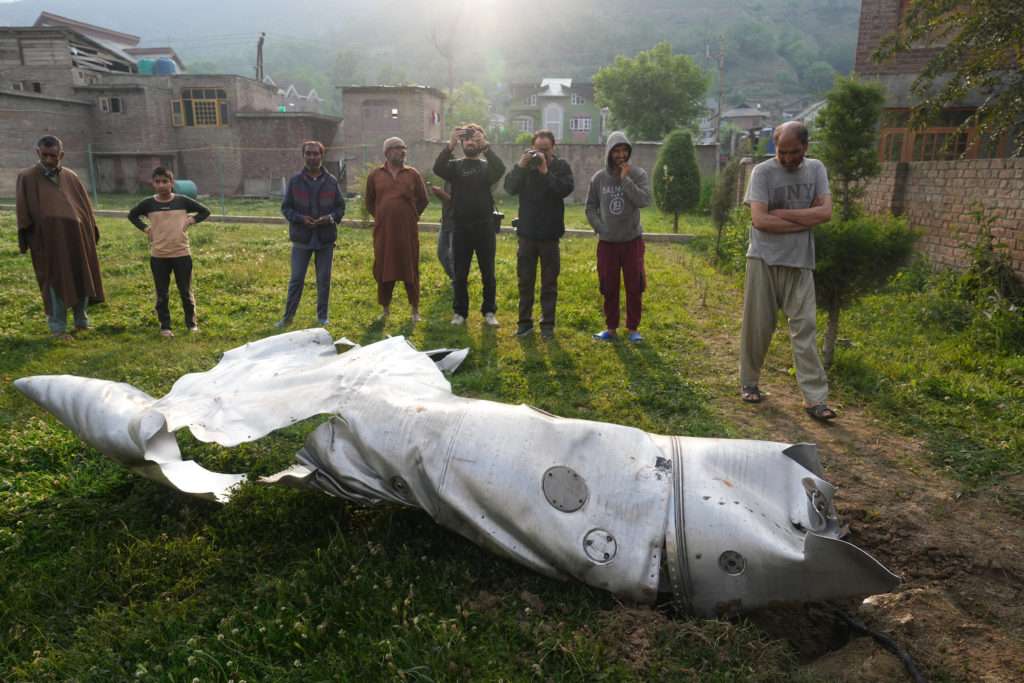
Despite this, India ensured:
- Immediate medical assistance to the injured.
- Counseling services for trauma-affected children.
- Ex-gratia payments for families of the deceased and displaced.
“India evacuated its people to protect them. Pakistan placed its civilians between its terrorists and our missiles.”
— J&K Relief Commissioner, May 2025
🧍♂️🧍♀️ Displacement and Civilian Fear in Pakistan
In Pakistan, the situation was both tragic and telling. While the Pakistani state claimed India “attacked innocent civilians,” the truth was far more uncomfortable:
In PoK and Punjab (Pakistan):
- Civilians in Bahawalpur, Muridke, Kotli, and Bhimber were seen fleeing en masse after Indian airstrikes targeted buildings co-located with terror infrastructure.
- Schools used as safehouses by JeM were hit—only because they weren’t schools in function, only in name.
- Hospitals were not targeted, but overwhelmed by injuries sustained due to Pakistani shelling near Indian retaliatory zones.
More importantly:
- No official civilian evacuation was initiated by the Pakistani government—despite knowing the locations of Indian targeting.
- Local mayors in cities like Muzaffarabad were later reported (by Pakistani outlets) as having begged ISPR to relocate militants away from population centers.
“We told them—please remove the fighters from the mosque compound. They didn’t listen. They put their weapons on the roof instead.”
— Eyewitness account from Kotli, leaked on social media
🩺 Healthcare System Overload
- In India, all major hospitals in Punjab and Jammu were placed on war footing. Dedicated trauma centers were activated.
- No hospital exceeded 80% capacity.
- Telemedicine lines were opened for border residents too afraid to travel.
- No hospital exceeded 80% capacity.
- In Pakistan, the strikes revealed:
- No wartime triage protocol.
- No civilian emergency reserves.
- Hospitals like Bahawalpur Civil Hospital were reportedly used to treat injured militants first, before civilians—according to a whistleblower account.
- No wartime triage protocol.

🕌 Religious Sites and Psychological Trauma
- India’s religious sites targeted:
- A Hindu temple in Jammu and a Sikh gurdwara in Poonch were both hit by Pakistani drone shrapnel.
- Caused national outrage. India documented these as potential war crimes.
- A Hindu temple in Jammu and a Sikh gurdwara in Poonch were both hit by Pakistani drone shrapnel.
- Pakistan’s false flag attempt:
- Claimed India bombed the Gurdwara Janam Asthan in Nankana Sahib.
- Denied by Sikh global councils and debunked by geospatial analysis.
- Claimed India bombed the Gurdwara Janam Asthan in Nankana Sahib.
Psychological Toll:
- Children in Indian border schools now undergo trauma therapy after experiencing drone alarms and shell explosions.
- Families in PoK live in fear, not because of India, but because of militants using their rooftops to fire rockets.
“India’s citizens were shielded by its military. Pakistan’s citizens were used by its military.”
— Global Humanitarian Law Centre Report, May 2025
🧳 Refugee Crisis Avoided—Thanks to Swift Indian Response
Despite over 20,000 people being displaced during the five-day conflict, India prevented a full-blown refugee crisis through:
- Pre-emptive village evacuations before Pakistan escalated.
- Rapid response shelter construction near Srinagar and Pathankot.
- Food, water, medicine, and mental health support via civilian-military coordination teams.
In contrast, Pakistan left its border populations to fend for themselves while focusing state media on false narratives and victory parades.
📌 Global Humanitarian Watchdogs React
Organizations like the Red Cross, UNHCR, and Médecins Sans Frontières monitored the situation closely.
Their internal assessments (leaked to the press) concluded:
- India complied with all rules of armed conflict.
- Pakistan violated several norms, including:
- Targeting of civilian zones.
- Use of dual-purpose buildings (mosques, schools) for military activity.
- No clear demarcation of non-combatant zones.
- Targeting of civilian zones.
🧨 Final Analysis
| Humanitarian Principle | India | Pakistan |
| Civilian Protection | High – evacuations, shelters | Low – used civilians as shields |
| Health Infrastructure | Functional & Prepared | Overloaded & Prioritized Militants |
| Religious Sites Targeted | Yes – by Pakistan | False flags used against India |
| Psychological Trauma Response | Ongoing counseling, safe zones | None – civilians left exposed |
| Global Law Compliance | Affirmed by neutral agencies | Under scrutiny for violations |
Verdict:
India’s restraint prevented catastrophe. Pakistan’s recklessness created it. The humanitarian fallout of Operation Sindoor was caused not by war—but by the way each country chose to fight it.
Official Statements and Political Messaging
In modern conflict, victory isn’t declared just in airspace or territory—it’s declared in narratives. How governments frame their actions, justify their intentions, and explain consequences can define public perception as much as military outcomes. And during Operation Sindoor, India mastered the message of measured strength, while Pakistan scrambled to salvage pride through a mix of denial, deflection, and deception.

🇮🇳 India: Clarity, Restraint, and Strategic Signaling
India’s political and military leadership spoke with unified precision throughout the conflict. Their tone was assertive, not boastful; their facts, verifiable; their restraint, strategic.
🔹 Prime Minister Narendra Modi:
- Canceled a high-level Europe tour to stay in New Delhi during the operation—projecting seriousness.
- Made no grand public speeches, choosing instead to let actions speak louder.
- Authorized all communications through defense and foreign affairs channels to prevent escalation through rhetoric.
“India will not tolerate terror. Our forces have shown that this time, the cost of bloodshed will be real, targeted, and irreversible.”
— PM Modi (post-ceasefire statement)
🔹 Defence Minister Rajnath Singh:
- Briefed Parliament with transparency:
- Confirmed targets were terror camps, not civilian centers.
- Claimed over 100 militants eliminated, including high-value targets.
- Confirmed targets were terror camps, not civilian centers.
- Reassured the public: India did not seek war, but would not shy away from one if provoked again.
🔹 Foreign Secretary Vikram Misri:
- Delivered all formal diplomatic briefings:
- Announced ceasefire timing.
- Accused Pakistan of deliberately violating international law.
- Clarified India’s position: No territory sought, no civilians targeted—only justice delivered.
- Announced ceasefire timing.
“This was not an attack on Pakistan. It was a strike on the cancer within it.”
🧠 Strategic Messaging Techniques:
- India released drone footage, satellite images, and before-after visuals of strike zones—proving the presence of terrorist camps.
- Used fact-based press briefings, avoiding any communal or religious framing.
- Avoided emotional rhetoric, leaving Pakistan to flounder in dramatic overreach.
Pakistan: Denial, Disinformation & Delusion
Pakistan, facing domestic pressure, international skepticism, and military embarrassment, defaulted to its familiar playbook:
🔻 Prime Minister Shehbaz Sharif:
- Referred to Indian action as a “cowardly assault”, but failed to explain why terror groups operated freely from Pakistani territory.
- Declared a national holiday (Yaum-e-Tashakur) after the ceasefire—celebrating the fact that Pakistan “survived,” not succeeded.
- Promised “justice” to Pakistanis, even as his government failed to acknowledge civilian risks posed by co-locating terror groups near homes.
🔻 Major General Ahmed Sharif Chaudhry (ISPR Spokesperson):
- Held theatrical press conferences, using:
- Poorly edited videos
- Unverifiable intercepts
- Inflated kill claims (e.g., “India lost 50 soldiers”)
- Poorly edited videos
- Denied all Indian accusations, while failing to explain how Indian drones penetrated Pakistani radar zones at will.
“The Indian narrative is a fabrication, our air defense remains intact.”
— ISPR Briefing, May 8
(Hours after India disabled two Pakistani radar stations)
🔻 Foreign Minister Ishaq Dar:
- Announced the ceasefire but labeled it as “mutual,” despite India offering no concessions.
- Accused India of violating international law, while refusing an international investigation into the Pahalgam massacre.
China: Silent Enabler, Loud in Hypocrisy
China’s political messaging followed a textbook pattern of strategic ambiguity:
- Called for “restraint on both sides” while never condemning Pakistan’s sponsorship of terrorism.
- Urged India not to escalate, but said nothing when Pakistani drones struck Indian civilian targets.
- Behind the scenes, reportedly told Islamabad to “wrap it up,” fearing the war would expose Chinese drone and radar tech as ineffective.
“China plays the arsonist and the firefighter—it arms Pakistan, then urges India to hold back.”
— Indian Strategic Analyst, IDSA

United States: Diplomatic Neutrality, Strategic Blindness
America’s official tone was that of a concerned referee, despite years of funding Pakistan’s security apparatus.
- President Trump:
- Brokered the ceasefire (and tweeted it first).
- Congratulated both sides for “acting with common sense.”
- Never called out Pakistan for terrorism, even after intelligence confirmed JeM links to Pahalgam.
- Brokered the ceasefire (and tweeted it first).
- Secretary of State:
- Urged both countries to de-escalate.
- Offered to mediate if “both sides agreed”—a diplomatic platitude that ignored the asymmetry of the conflict.
- Urged both countries to de-escalate.
“Washington wants calm in South Asia, but refuses to admit who breaks it every time.”
— Indian Diplomat to U.S. counterpart, May 2025
📰 International Media Reaction
| Outlet | Coverage Highlight | Position |
| BBC | “India targets terror camps; Pakistan strikes back” | Balanced but factual |
| CNN | “Deadly drone war between two nuclear rivals” | Alarmist tone, missed context |
| Al Jazeera | “India must stop provoking Pakistan” | Clearly sympathetic to Islamabad |
| Reuters | “Pakistani claims of Indian aircraft kills unverifiable” | Factual, skeptical of ISPR |
| The Times (UK) | “Modi’s India won’t back down anymore” | Supportive of India’s firm stance |
🧨 Final Analysis: Messaging vs Reality
| Category | India | Pakistan |
| Narrative Focus | Anti-terrorism, precision, deterrence | Victimhood, religion, false parity |
| Tone | Strategic, restrained, evidence-based | Theatrical, inconsistent, reactive |
| Media Strategy | Verified visuals, formal briefings | Memes, fake videos, ISPR propaganda |
| Global Sympathy Earned | Widespread | Thin, limited to habitual allies |
Verdict:
India spoke like a responsible power. Pakistan shouted like a guilty party. The world noticed.
International Reactions and Media Coverage
The world watched with unease as two nuclear-armed neighbors edged toward open conflict during Operation Sindoor. But unlike previous Indo-Pak clashes, this time the global response was measured, methodical, and—most tellingly—unsympathetic to Pakistan’s usual narrative.
What emerged was a sharp divide between nations that called for de-escalation and those that dared to name the real provocateur. While India earned quiet approval for its restraint and precision, Pakistan found itself diplomatically cornered, with even its long-time patrons offering little more than recycled platitudes.
🌍 Global Diplomatic Reactions
🇺🇸 United States – The Peacemaker with Selective Memory
- Played a central role in brokerage of the ceasefire, with President Trump personally engaging with both sides.
- Despite its long-term knowledge of Pakistan’s terror links, Washington issued generic statements urging both nations to show restraint.
- Never explicitly condemned the Pahalgam massacre or the terrorist groups based in Pakistan.

“It’s unfortunate to see violence again in South Asia. We hope India and Pakistan use dialogue, not drones.”
— U.S. State Department
Behind the scenes: U.S. intelligence reportedly provided India tacit satellite support for confirming terror camp locations, but this cooperation was never acknowledged publicly.
China – The Two-Faced Silent Operator
- Called for “restraint from both sides”, while continuing to supply:
- Pakistani drone hardware
- Electronic warfare kits
- Strategic missiles used during Operation Bunyan al-Marsus
- Pakistani drone hardware
- Never addressed India’s allegations of Chinese-supplied tech being used against civilians.
“We urge both countries to solve issues peacefully.”
— Chinese Foreign Ministry (meanwhile, PLA cyber units quietly supported Pakistani operations)
China’s hypocrisy was so blatant that several Indian officials referred to it as “the true third party in this war.”
Russia – Quiet Support for India
- Called the Indian response “measured and responsible.”
- Emphasized the need to combat terrorism through coordinated security architecture.
- Offered to help mediate long-term stability mechanisms via SCO (Shanghai Cooperation Organisation).
Russia’s credibility as a partner increased after it backed India’s S-400 deployment, helping intercept Pakistan’s missile threats effectively.
Saudi Arabia & 🇦🇪 UAE – Economic Leverage, Not Sympathy
- Urged Pakistan to de-escalate or risk jeopardizing ongoing financial aid and infrastructure deals.
- Made behind-the-scenes calls to both New Delhi and Islamabad to contain the conflict.
- UAE offered to host follow-up peace talks—a move welcomed by India but treated with hesitation by Pakistan.
“We support regional peace, but countries must ensure terrorists don’t find shelter on their soil.”
— UAE Foreign Affairs Advisor (a thinly veiled warning to Islamabad)
European Union – Balanced but Increasingly Wary of Pakistan
- Called for restraint but did not equate India’s counterterrorism strikes with Pakistan’s civilian-targeting responses.
- Several EU MEPs released statements supporting India’s right to self-defense, particularly after images of the Pahalgam massacre victims circulated online.
📰 International Media Coverage: Fact-Based, Not Fantasy-Driven
In a notable shift from previous conflicts, mainstream international media outlets did not fall for Pakistan’s victim narrative. Instead, many presented facts supported by satellite images, intelligence leaks, and third-party military analysts.
🗞️ Headlines Snapshot:
- Reuters: “India strikes deep into terror hubs in Pakistan; retaliation escalates”
- The Times (UK): “Modi’s India draws a red line—terror groups can’t hide behind borders anymore”
- BBC: “Escalation over Kashmir exposes Pakistan’s use of drones, risks regional conflict”
- Wall Street Journal: “Drone war in South Asia reveals China’s quiet hand behind Pakistan’s retaliation”
- Al Jazeera: “Civilian cost mounts as India and Pakistan trade fire”—(one of the few to still frame both sides as equally culpable)

📺 Broadcast Analysis:
- CNN International ran interviews with former U.S. intelligence officials who admitted JeM’s fingerprints were visible in the Pahalgam attack, despite Pakistan’s denials.
- France24 ran special coverage explaining the legality of India’s strikes under international counterterrorism norms.
- DW News (Germany) highlighted how India avoided civilian infrastructure while Pakistan struck Indian temples and schools.
“Pakistan may have lost more than just infrastructure in this conflict. It lost whatever credibility it still had.”
— The Economist, May 12, 2025
🧠 Think Tanks and Strategic Commentators
Several global security analysts weighed in:
- Michael Kugelman (Wilson Center):
“This was the closest the region has come to conventional war in years—but India showed strategic restraint, and Pakistan lost the battle for moral ground.” - Carnegie Endowment for International Peace:
“Pakistan’s failure to control groups like JeM has global implications. It cannot expect sympathy while sheltering militants.” - Brookings Institution:
“The drone engagements of May 2025 may become the case study for limited modern warfare. India stayed within norms, Pakistan didn’t.”
🌐 Global Public Sentiment: Sympathy Tilts Toward India
Across social media platforms and public forums:
- Hashtags like #IndiaStrikesBack, #JusticeForPahalgam, and #StopPakTerror trended in dozens of countries.
- Pakistani campaigns such as #IndiaTerrorismExposed failed to gain traction.
- Prominent international figures, including journalists, ex-military officers, and human rights activists, challenged Pakistan’s claims of innocence and called for terror accountability.
“You can’t let terror groups operate from your backyard and cry foul when someone throws a stone back.”
— Former NATO Commander, viral post on X

Strategic Analysis and Military Lessons
Operation Sindoor was not just a regional military engagement. It was a transformative episode in South Asian strategic doctrine—one that shattered outdated assumptions, validated modern deterrence models, and exposed the fault lines in Pakistan’s long-preferred proxy warfare strategy.
The conflict will be studied for years to come—not just for what happened, but for what didn’t happen: no ground invasion, no escalation to nuclear threats, no ambiguity about who was right or wrong.
🧠 Key Lessons for India: Precision Pays Off
✅ 1. Stand-Off Strikes Work When Intelligence is Real-Time
- Use of SCALP missiles, loitering munitions, and satellite-guided bombs gave India a critical advantage.
- Zero need for risky ground troop movements.
- Enemy camps neutralized without crossing international borders, preserving diplomatic leverage.
“Distance is no longer safety for terror sponsors. Precision now has range.”
— DRDO Missile Command Official
✅ 2. Drone Warfare Is the New Battlefield Normal
- India’s drone capability, particularly in swarm suppression and SEAD missions, disoriented Pakistan’s air defense grid.
- Integration of AI, real-time ISR, and autonomous targeting made India’s drone fleet battle-proven.
- Result: India now commits to expanding Project Trinetra—its indigenous armed drone program.
✅ 3. Restraint Wins Global Respect
- By targeting only terrorist infrastructure, India not only hit harder—it emerged as a disciplined, rules-bound democracy.
- Even U.S. officials and EU diplomats privately admitted that India’s conduct was textbook counterterrorism—not escalation.
📉 Lessons for Pakistan: Outdated Doctrine, Overplayed Hand
❌ 1. Proxy Warfare Has an Expiry Date
- The idea that Pakistan can use non-state actors as deniable assets is no longer viable.
- The world saw:
- JeM headquarters bombed in Bahawalpur
- LeT arms cache in Muridke reduced to rubble
- JeM headquarters bombed in Bahawalpur
- Pakistan can no longer say “we didn’t know they were there.”
“When terrorists live in your compounds and die in your strikes, it’s no longer plausible deniability—it’s complicity.”
— Retd. Indian Intelligence Chief
❌ 2. Chinese Tech Doesn’t Offset Poor Strategy
- Despite deploying J-10C jets, Songar drones, and Fatah-II guided rockets, Pakistan failed to:
- Prevent Indian penetration of its radar zones
- Shoot down a single Indian drone with confirmed kills
- Protect its airbases from SEAD attacks
- Prevent Indian penetration of its radar zones
- In effect, Chinese hardware didn’t translate to battlefield success, exposing the myth of Sino-Pakistan military synergy.
❌ 3. Information War Needs Credibility
- Pakistan’s propaganda collapsed under scrutiny:
- Fabricated videos debunked by OSINT groups.
- Claims of Rafale kills fell apart under lack of wreckage.
- False allegations about religious site attacks backfired diplomatically.
- Fabricated videos debunked by OSINT groups.

“Pakistan used more Photoshop than firepower. And it failed at both.”
— The Print (India)
🧪 Strategic Concepts Reinforced
📌 1. Limited War Under Nuclear Umbrella Is Possible
- Operation Sindoor proved that calibrated, high-tech engagements can occur between nuclear-armed neighbors without crossing the escalation threshold.
- No nuclear rhetoric was needed, or used.
- Clear takeaways for deterrence theorists and military planners worldwide.
📌 2. Civilian Infrastructure Should Not Host Militants
- Pakistan’s decision to embed terror networks within schools, mosques, and homes not only endangered civilians—it invited lawful counterstrikes.
- International observers privately acknowledged that India struck legally protected terror targets, not civilian populations.
📌 3. Cyber and Drone Warfare Need Rules of Engagement
- Both countries deployed offensive cyber tools and drones—but only India integrated them with ethical military conduct.
- The need for cross-border protocols on drone use, especially around civilian zones, is now critical.
🌍 Broader Implications for the Region
🌐 For India:
- Emerges as a military-tech-enabled regional power.
- Sends a message to other hostile actors (state and non-state): terrorism will be met with fire, not files.
- Strengthens case for UN Security Council reform, based on strategic maturity.
🌐 For Pakistan:
- Loses diplomatic ground with every falsehood.
- Faces rising internal dissent, as civilians question why terrorists were living in their cities.
- Strategic partnerships (with China and others) now viewed as liabilities, not leverage.
🌐 For China:
- Exposed as an indirect actor in regional instability.
- Quietly reprimanded by Europe for its dual-use exports.
- Its role as a “peace advocate” now rings hollow.
🌐 For the United States:
- Once again, forced to play referee, while avoiding taking a moral stand.
- Still refuses to label Pakistan a state sponsor of terror, despite decades of evidence.
- Quietly aided India—but lost credibility by failing to speak out against the original crime: the Pahalgam massacre.

🧨 Final Verdict: A Doctrinal Reset
| Country | Strategic Win | Tactical Success | Moral High Ground |
| India | ✅ Yes | ✅ Yes | ✅ Yes |
| Pakistan | ❌ No | ❌ No | ❌ No |
| China | ❌ No (exposed) | ⚠️ Partial | ❌ No |
| U.S. | ⚠️ Partial | ✅ Brokered peace | ❌ Lacked clarity |
Operation Sindoor will be remembered not just as a military strike—but as India’s coming of age as a 21st-century security actor, and Pakistan’s fall from plausible deniability into undeniable complicity. The world watched. And this time, it understood.
Impact on Kashmir and Indo-Pak Relations
Kashmir has long been the fault line of South Asia—the flashpoint where diplomatic tensions, terror ideology, and military posturing collide. With Operation Sindoor, India changed the rules of that game. What began as a direct response to the Pahalgam massacre turned into a strategic recalibration of how India deals with Pakistan and how it defines stability in the region.
Operation Sindoor was not just about eliminating terror camps. It was about drawing a red line in the snow-capped valleys of Kashmir—a red line backed by missiles, drones, and a government that finally chose deterrence over dialogue with a dishonest neighbor.
India’s Strategic Shift on Kashmir: From Defense to Dominance
🔹 Pre-Sindoor:
- India maintained a reactive posture, reinforcing troops after attacks but rarely crossing the LoC post-Balakot (2019).
- Relied heavily on diplomatic warnings, dossiers, and UN briefings.
- Allowed international actors to “mediate” without naming Pakistan’s role in promoting cross-border terrorism.

🔹 Post-Sindoor:
- India showcased a new doctrine: terrorism in Kashmir will be answered with direct, non-negotiable kinetic response.
- Clearly demonstrated that proxies won’t be treated separately from their sponsors—Pakistan and its security agencies are now strategic targets, not passive bystanders.
- Initiated steps to fortify border villages, install anti-drone grids, and equip local police with counterinsurgency tech.
“Kashmir’s peace can no longer be hostaged to Pakistan’s instability. We will dictate terms, not just react to terror.”
— Indian Home Minister, May 2025
🛡️ Security Improvements in Kashmir
- Indian forces deployed integrated surveillance towers, loitering drones, and automated mortar counter-batteries along vulnerable LoC sectors.
- New rules of engagement allow preemptive neutralization of potential infiltrators based on real-time satellite and drone intel.
- Civilian confidence in border areas has increased, with school attendance and tourism slowly recovering post-Sindoor.
📍 Intelligence Reforms:
- RAW (Research & Analysis Wing) and the National Investigation Agency (NIA) now treat foreign-backed terrorism as war-like sabotage, enabling faster counteraction without waiting for prolonged investigations.
- Kashmir’s administration received direct coordination access with the Defense Cyber Command to combat future psychological ops.
Pakistan’s Narrative on Kashmir—Now Defenseless
For decades, Pakistan has used Kashmir as the cornerstone of its foreign policy and domestic rhetoric, falsely projecting itself as a moral custodian of Kashmiri Muslims. Operation Sindoor shattered that illusion.
❌ Narrative Collapse:
- Global actors, even historically neutral ones, did not endorse Pakistan’s claims of Indian aggression.
- No country supported Pakistan’s call for international intervention or UN condemnation.
- Pakistan’s repeated use of groups like JeM and LeT to “defend Kashmir” was finally understood as what it is: state-sponsored jihadism.
“Operation Sindoor didn’t just break bunkers. It broke the myth of Pakistan’s Kashmir diplomacy.”
— International Crisis Group analyst
📉 Pakistan’s Diplomatic Isolation on Kashmir
- OIC (Organization of Islamic Cooperation) issued a token statement but refrained from naming India—a major departure from previous Kashmir-related stances.
- No major Western country backed Pakistan’s claim that India was the aggressor.
- Even China—its closest ally—remained diplomatically mute on the Kashmir front, possibly fearing exposure of its own tactics in Xinjiang and Tibet.

Pakistan now faces a dilemma:
- If it pushes the Kashmir issue diplomatically, it will be asked about terrorist safe havens bombed during Operation Sindoor.
- If it stays silent, it loses the one emotional cause that has kept its fractured national identity partly unified.
🕊️ Room for Dialogue? Unlikely, But Not Impossible
India has made it clear: talks can resume only when Pakistan dismantles its terror infrastructure—not before, and not in exchange for “peace gestures.”
🔐 India’s Demands for Future Talks:
- Dismantling of all camps tied to JeM, LeT, and Hizbul Mujahideen.
- Extradition or international cooperation on individuals like Masood Azhar and Sajid Mir.
- Immediate end to drone-based infiltration and narco-terror activities along the Punjab border.
📉 Pakistan’s Position:
- Publicly demands Kashmir be the first agenda item.
- Privately, it is now in no position to set terms, as its credibility has been undercut by:
- Global exposure
- Economic collapse
- Overdependence on China and Gulf bailouts
- Global exposure
“There can be no talks on Kashmir with a country that uses suicide bombers as ambassadors.”
— Indian National Security Advisor
🔎 New Strategic Norms in the Region
| Area of Impact | Pre-Sindoor | Post-Sindoor |
| Kashmir Terror Policy | Infiltration followed by denial | Preemptive targeting, strikes on safe havens |
| Diplomatic Messaging | “We seek peace” | “We act against threats—peace is conditional” |
| Military Posture | Defend LoC, minimal retaliation | Dominate LoC, retaliate with force and finality |
| Pakistan’s Narrative | Custodian of Kashmiri Muslims | Exposed patron of terrorists in civilian disguise |
🔔 Final Verdict
Operation Sindoor has redrawn the psychological and military map of Indo-Pak relations over Kashmir. For the first time:
- India dictated the tempo, narrative, and closure of conflict.
- Pakistan was caught off-guard, off-message, and off-balance.
- Kashmir, once hijacked as a pawn in Pakistan’s propaganda, has now been reframed as a red-line issue where no compromise on terror will be tolerated.
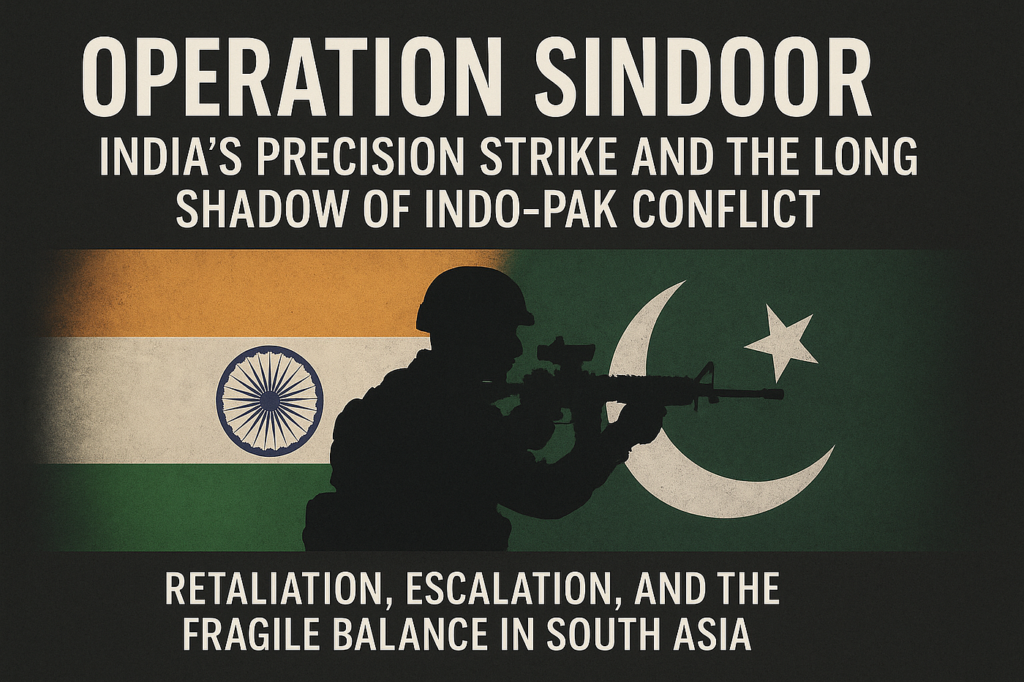
What’s Next? The Aftermath and Fragile Peace
As the dust settles after Operation Sindoor, the region remains calm—but tense. The ceasefire that took effect on May 10, 2025, continues to hold—but barely. Each side watches the other closely. Border patrols remain doubled. Drones still buzz overhead. The Line of Control has become a test of nerves, not just firepower.
Yet the bigger question remains: Was this the end of a dangerous cycle—or the beginning of a new phase in India’s security doctrine?
⚖️ The Ceasefire Holds—But Just Barely
Within 48 hours of the ceasefire:
- Explosions were reported in Srinagar, likely from Pakistani drones violating the truce.
- Indian radar tracked low-altitude incursions near Gurdaspur and Samba—none successful, but all documented.
- Both sides exchanged verbal warnings, but neither escalated militarily.
India’s official line:
“We will observe restraint, but we will not tolerate another Pahalgam. We’ll respond without warning, again.”
Pakistan’s line:
“India must respect the ceasefire or face consequences”—despite being the first to violate it.
India’s Post-Sindoor Strategy: Quiet Vigilance, Swift Justice
India has made it clear that the Sindoor Doctrine is here to stay:
- Any future terrorist attack traced to Pakistan will trigger:
- Stand-off missile strikes
- Drone swarm engagements
- Cyber disruption of Pakistani military infrastructure
- Stand-off missile strikes
- Diplomatic outreach continues:
- India shared classified strike evidence with trusted partners, including France, Israel, and the U.S.
- It plans to release a dossier to the United Nations, naming JeM and LeT camps destroyed during Sindoor.
- India shared classified strike evidence with trusted partners, including France, Israel, and the U.S.
Internally, India is:
- Fortifying its drone command structure
- Deploying counter-drone grids in Punjab and J&K
- Drafting new LoC rules of engagement—giving forward units the right to strike preemptively
“India’s new normal: preempt, punish, and publicize.”
— Strategic Affairs Adviser, Indian PMO
Pakistan’s Position: Militarily Silenced, Politically Cornered
Pakistan may have agreed to peace on paper, but its strategic thinking hasn’t evolved.
- No public action has been taken against JeM or LeT leadership.
- No military court trials, arrests, or terror camp dismantlings have occurred.
- Instead, Pakistan’s state media has resumed its old playbook:
- Blame India
- Call for UN intervention
- Claim moral high ground while sheltering extremists
- Blame India
Behind closed doors:
- Military morale is fractured, especially after ISPR’s exaggerated kill claims were debunked.
- Civil society in Pakistan is now questioning:
- Why were terrorist groups operating in civilian zones?
- Why were they the first to be hit—and why was the government silent?
- Why were terrorist groups operating in civilian zones?
🌍 International Community: Watching, Waiting, Wary
The world may have helped broker peace, but it has not forgotten Pakistan’s role in triggering the crisis.
- U.S. officials have quietly pushed Islamabad to dismantle known terror networks or risk sanctions.
- European diplomats have begun classifying JeM and LeT not just as threats to India—but to global security.
- Saudi Arabia and the UAE have reportedly paused new aid packages pending Pakistan’s counterterrorism cooperation.
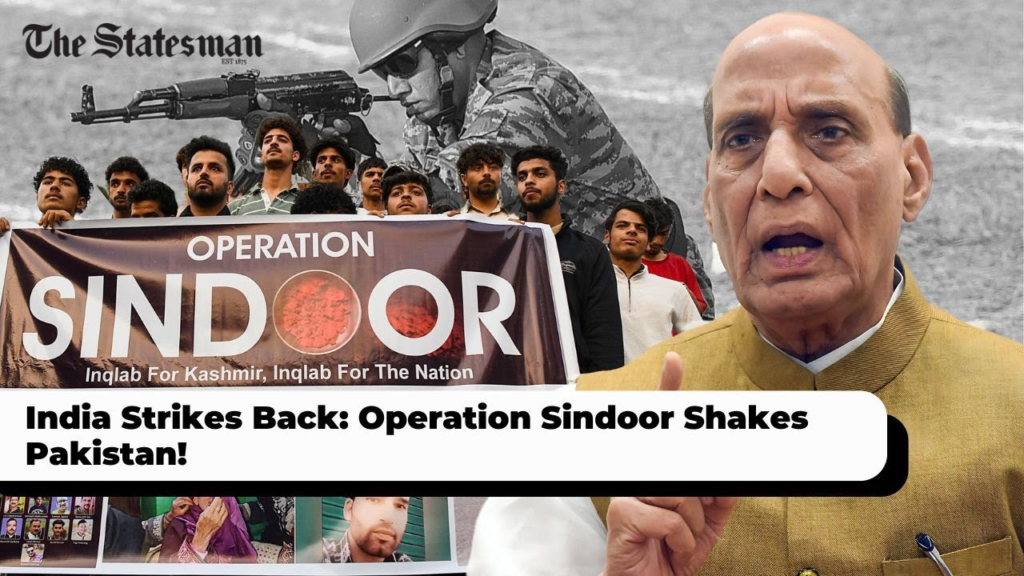
“The world didn’t just de-escalate this war. It diagnosed the disease: Pakistan’s addiction to terror.”
— European Parliament Statement, May 2025
🛑 Risks Ahead: What Could Break the Truce
Despite diplomatic progress, several flashpoints could reignite hostilities:
🔺 1. Another Terror Attack on Indian Soil
- If Pakistan-based groups strike again, India is unlikely to wait for global validation.
🔺 2. Cross-Border Drone Incursions
- Pakistan’s use of Chinese-assisted drones makes future LoC violations likely.
- India has warned: even one drone over Indian soil could trigger immediate retaliation.
🔺 3. Internal Political Shifts
- If Pakistan’s military regime feels threatened internally, it may divert attention with cross-border provocation—a tactic used before.
🕊️ What It Will Take to Build Real Peace
Real peace requires more than ceasefires. It requires Pakistan to:
- Completely dismantle terror safe havens.
- Reform its military-intelligence complex, especially the ISI.
- Acknowledge the truth about the Pahalgam massacre, and who enabled it.
India, on its part, remains open to dialogue—but not diplomatic theatre.
“Peace is possible. But not on the terms of those who send bombs with blessings.”
— Indian Foreign Secretary
🔚 Final Word: A Turning Point, Not the End
Operation Sindoor was not a war. It was a strategic correction—a reminder to Pakistan that time and tolerance for terrorism have run out.
- India showed the world that it can act with power and principle.
- Pakistan was forced to choose between fantasy and fact—and still struggles.
- The region is quieter today—but only because India made the cost of silence impossible to ignore.
Conclusion
Operation Sindoor was a turning point in India’s national security doctrine—a bold, precise, and necessary response to decades of unchecked terrorism emanating from Pakistan. It exposed Islamabad’s complicity, China’s silent support, and the dangers of global silence. More importantly, it showed that India will no longer wait to be wounded before striking back. The message is clear: terror has a cost, and India will make sure it’s paid in full.
You might also be interested in – Turkish, Azerbaijani & Malaysian Brands and Products to Avoid in India


